

THE ARTFUL MIND




the ARTFUL MIND
IN PRINT SINCE 1994
“Everything has its season - everything has its time. Show me a reason and I will soon show you a rhyme... Gotta find my corner of the sky.” Pippin —Bob Fosse
CALENDAR of Artful Events 4
Interview: Beckie Kravetz
Mask Maker and Contemporary Figurative Sculptor ... 10
Elizabeth Cassidy In Other Words | POETRY 21
Interview: Imelda O’Reilly Filmmaker
Photography on cover by Rachel Neville... 24
Richard Britell | FICTION
Valeria and the Ants CHAPTER 3 ... 47
Diaries of Jane Gennaro
Mining My Life FINALE EPISODE “Hip Story” .... 48

Publisher Harryet Candee
Copy Editor Elise Francoise
Contributing Photographers
Edward Acker Tasja Keetman Bobby Miller
Contributing Writers
Richard Britell Jane Gennaro
Third Eye Jeff Bynack

Distribution Ruby Aver
CALENDAR / ADVERTISING EDITORIAL / SUBSCRIPTIONS — 413-645-4114
EMAIL: ARTFULMIND@YAHOO.COM
Read every issue online: ISSUU.COM and YUMPU.COM / instagram
Join the FB group: ARTFUL MIND GALLERY for Artful Minds 23 THE ARTFUL MIND PO Box 985, Great Barrington, MA 01230
FYI— Disclaimer: : ©Copyright laws in effect throughout The Artful Mind for logo & all graphics including text material. Copyright laws for photographers and writers throughout The Artful Mind. Permission to reprint is required in all instances. In any case the issue does not appear on the stands as planned due to unforeseeable circumstances beyond our control, advertisers will be compensated on a one to one basis. All commentaries by writers are not necessarily the opinion of the publisher and take no responsibility for their facts and opinions. All photographs submitted for advertisers are the responsibility for advertiser to grant release permission before running image or photograph. Not responsible for photo content /copyright brought into magazine by other artists promoting other artists in editorial on these pages.
JOANE CORNELL FINE JEWELRY


COMMISSION ORDERS WELCOMED Toggle Necklace and Bracelets
Hand Forged Designs


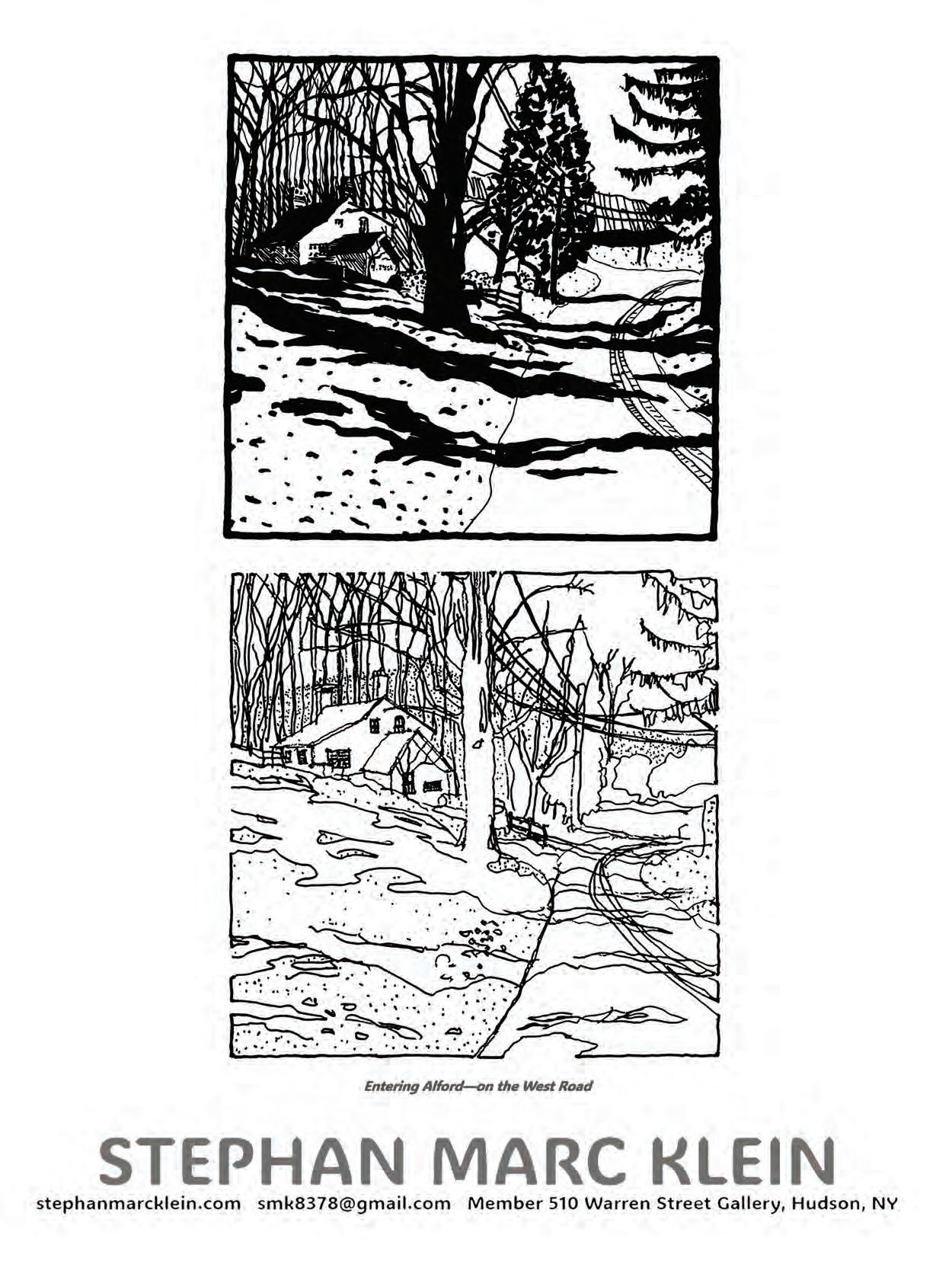
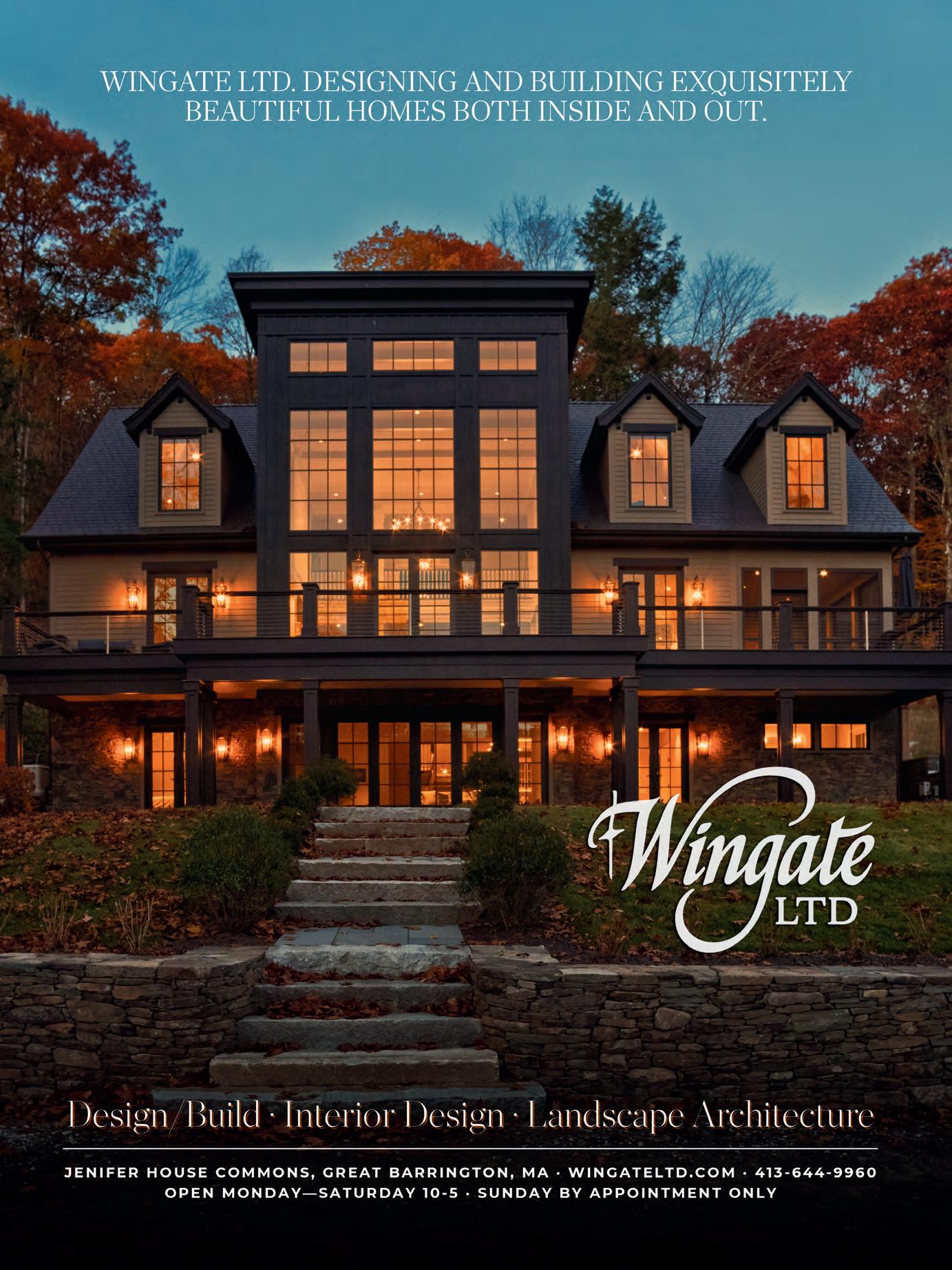
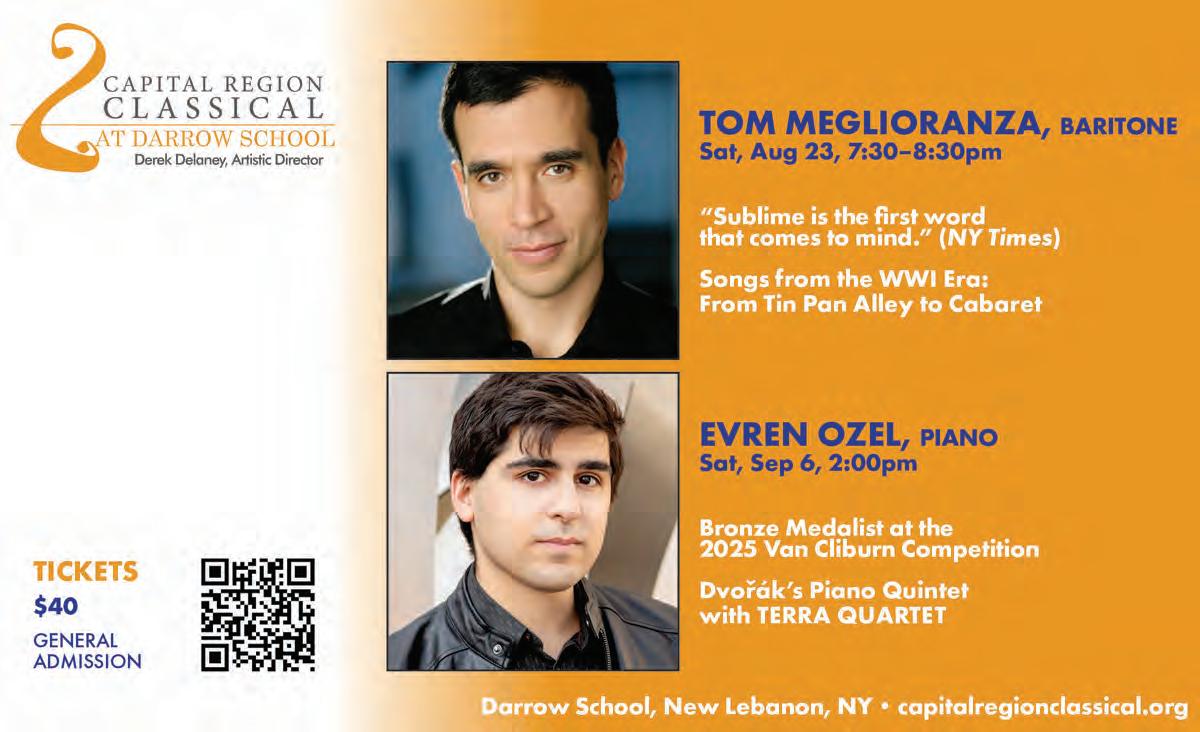
DON LONGO
As this painting developed, I wanted to make sure it had the feeling of a late springtime day after an evening of light snow. Just when you started to get used to it all being gone, it snows again for another quick dusting. It's mother nature's last winter breath as it blankets the hills just to say, "I'm not done with you yet!"
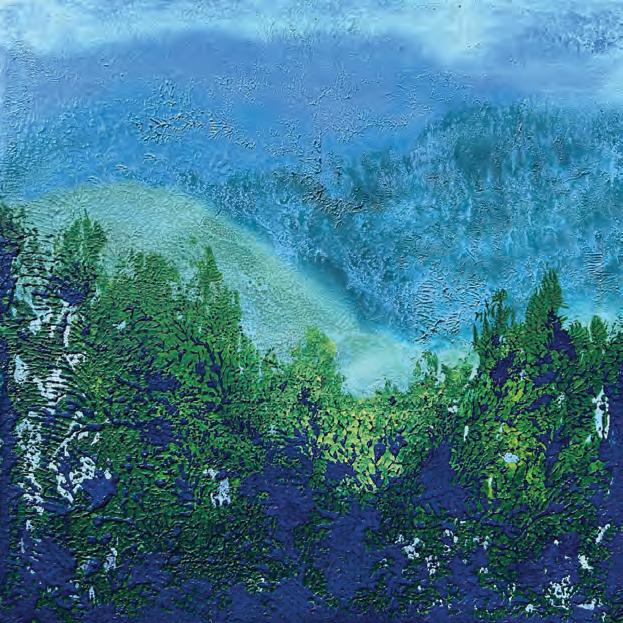
BERKSHIRE MEMORIES - Late Spring in the Hills. 20" x 20" Acrylics and Enamel Paint on canvas.

CALENDAR of EV E NTS
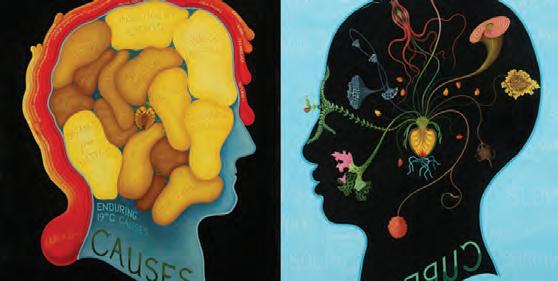
Allison Pebworth: Cultural Apothecary
October 1 - December 31
1040 Mass MoCA Way, North Adams, MA
ART
510 WARREN STREET GALLERY
510 Warren st, Hudson NY 518-822-0510 / 510warrenstgallery@gmail.com Featured artists each month.
CORRIDOR GALLERY
185 E. Main st, North Adams, MA
The Corridor Gallery is an experimental exhibition space set in the grand entryway of the Walkaway House. The Corridor Gallery is a project of artist and founder Carolyn Clayton and is activated by the work and vision of guest artists and individuals.
CHILDS + CLARK GALLERY
684 Main Street, Unit 1, Great Barrington, MA Ceramics, Glass, Painting, Sculpture, Fiber.
BECKET ARTS CENTER
7 Brooker Hill Rd, Becket , MA 413-623-6635 office@becketartscenter.org
Special Members Exhibition; Macrocosm: July 25Aug 17.
BERKSHIRE BOTANICAL GARDEN
5 West Stockbridge Rd, Stockbridge, MA 413-298-3926 BerkshireBotanical.org
June 6- Aug 11: DayDream, Curated by James Salomon; Also: Sleepwalkers, in conjunction with “DayDream”, an outdoor exhibit by renowned sculptor Mark Mennin
BERNAY FINE ART
296 Main st Gt Barrington, MA 413-645-3421
July 12 - Aug 10: Summertime: annual Summertime show. The show will feature paintings by Janet Rickus, Joy Taylor and Linda Pochesci, prints by Lawre Stone and sculpture by Joy Brown.
CARRIE HADDAD GALLERY
622 Warren St, Hudson, NY info@carriehaddadgallery.com
Aug 1 - Sept 21: Weathered
THE CLARK ART INSTITUTE
225 South St, Williamstown, MA 413-458-2303
July 12 - Oct 5: Berenice Abbott’s Modern Lens

CLOCK TOWER ARTISTS’ STUDIOS & GALLERY
75 S. Church St, 3rd fl, Pittsfield, MA clocktowerartists.com
The Clock Tower Artists is a collective of working artists, see website for artists and open studio visits.
CHESTERWOOD
4 Williamsville Rd, Stockbridge, MA chesterwood@savingsplaces.org
47th annual contemporary outdoor sculpture exhibition
FREYLINGHUYSEN MORRIS HOUSE AND STUDIO
92 Hawthorne St, Lenox, MA
Visit the home of American Abstract Artists George L.K. Morris and Suzy Frelinghuysen, set on a 46-acre estate in the heart of Lenox, Massachusetts.
FUTURE LAB(S) GALLERY
43 Eagle St, North Adams, MA Ongoing art exhibits
GALLERY NORTH
9 Eagle St, North Adams, MA 413-663-1509
A fine art gallery featuring artists in many mediums
GREYLOCK GALLERY
71 Sprig St, Williamstown, MA 413-884-6926
Oil paintings, landscapes and whimsical metal sculptures-traditional and contemporary art. Aug: Teri Malo. Leslie Peck
GUILD OF BERKSHIRE ARTISTS
www.berkshireartists.org
STILL LIFE – curated by Lori Bradley: Artists – Lori Bradley, Mary Davidson, Keith Davidson, Margie Skaggs. Running from Thurs, July 31— Mon, Sept 1. Opening Day - Thurs July 31– 11am - Closes Mon. Sept. 1 (Labor Day) Thursdays 1-6 pm and Fridays thru Sundays, 11- pm. Opening Reception - Sat. Aug 2 -2- 4pm.
HUDSON MILLINER ART SALON
415 Warren St, HUdson Ny info@hudsonmillinerartsalon.com
Through Oct: Charlotta Janssen:Smells Like Team Spirit. The Hudson Milliner Art Salon is a creative and collaborative art space featuring art and performance as well as the intersection of the two. We feature exploratory, edgy and political work.
LAUREN CLARK FINE ART
684 Main St, Gt Barrington, MA
Lauren@LaurenClarkFIneArt.com
Fine art, glass, sculpture and paintings
MASS MoCA
1040 MASS MoCA WAY, Hunter Center, North Adams, MA info@massmoca.org
Through August 2026: Jeffrey Gibson: Power Full Because We’re Different. A commissioned immersive installation filling MASS MoCA’s signature Building 5 gallery that follows Gibson’s highly celebrated United States representation at the 60th edition of La Biennale di Venezia.
MCLA GALLERY
375 Church St, North Adams, MA 413-662-5000
July 18 - Sept 28: I Am Too, A Piece of Clay: LaRissa Rogers
NORMAN ROCKWELL MUSEUM
9 Glendale Road, Stockbridge, MA 413-298-4100
July 12 - Oct 26
Hidden Worlds and Wonders: Outdoor Sculpture Exhibition Juried Show: Artists
PAMELA SALISBURY GALLERY
362 1/2 Warren St, Hudson, NY Ongoing art exhibits.
PETER JUNG FINE ART
19th & 20th Century Paintings
512 Warren Street Hudson, NY Phone: 518-755-4350
peterjung512@gmail.com Ongoing art exhibits
ROAM
16 Water St, Williamstown, MA roamgallery.photo/
ROAM A Xtina Parks Gallery is an African Contemporary Art Gallery and Fair Trade showroom specializing in works of art, sculpture, African wildlife photography, ceramics & pottery, vintage textiles, jewelry, woven baskets and much more.
ROBIN RICE GALLERY
FINE ART + PHOTOGRAPHY
234 Warren St, Hudson NY
Jul 12-Sep 7: Giacomo Piussi "Friends of Friends"
What to do In and around the berkshires .

Tanglewood Recital Series: AUGUST 13
Brooklyn Rider, Seiji Ozawa Hall, Lenox/Stockbridge, MA

HOTEL ON NORTH
Sally Tiska Rice
Will be the featured artist at the Hotel on North, located at 297 North Street, Pittsfield, MA through September 1, 2025. Set in the heart of downtown Pittsfield, this beautifully restored boutique hotel blends 19th-century architecture with sleek, contemporary design— and is the perfect backdrop for Sally’s richly layered, light-filled artwork.

2
SOHN FINE ART
69 Church St, Lenox, MA
413-551-7353 info@sohnfineart.com
Aug 1 - Oct 6: Blaze, Smolder, Char
SOUTHERN VERMONT ARTS CENTER
860 SVAC Drive / West Rd, MAnchetser VT SVAC.ORG
Through January 4, 26:
Into the Abstract: Paul Gruhler and Neha Vedpathak
SUSAN ELEY FINE ART
433 Warren St., Hudson, NY
July 31 - Sept 2: 2D - 3D - 2025: New Abstractions by Andrew Hildenbrand & Jared Abner
THE ARTFUL MIND
Fine Art and Mixed Media GROUP Art Exhibit 11 Eagle St, North Adams, MA 413 - 645 - 4114 Wed - Sun 11 - 4:30 Please call ahead if coming from a distance.
THE MARKETPLACE CAFE PITTSFIELD
53 North St, Pittsifeld, MA
Mary Davidson will be showcasing her "Abstract Series" of stamped paintings, with an opening reception from 5 to 7 pm during the Artswalk, Aug 1 First Fridays.
THE RE INSTITUTE
1395 Boston Corners Rd, Millerton, NY
July 12 - Aug 23: Irrigation; Upstairs: Gregory Klassen; Downstairs: Ruby Jackson and friends
TIVOLI ARTISTS GALLERY
60 Broadway, Tivoli, NY
July 11 - August 10: Reception Saturday July 12 57pm"Hudson Valley Towns" "Interpretations of our Beautiful Hudson Valley Villages, landmarks and Vistas"
TURNPARK ART SPACE
2 Moscow Rd, West Stockbridge, MA
May 17-Aug 10: Jim Morris: Leaving Traces; Aug 13Oct 31: John Clarke: Passing Through
NEW MARLBOROUGH MEETING HOUSE
154 Hartsville, New Marlborough Rd New Marlborough, MA
July 25 -Aug 24. “Elemental: earth / air / water” Aug 29-Oct 5: “Black and White and What Lies Between” Reception: Aug 29, 5-7 pm
THEATER
BERKSHIRES THEATRE GROUP
www.berkshiretheatregroup.org
The Unicorn Theatre
6 East St, Stockbridge, MA
Aug 7 - Aug 30: Dying Is No Excuse
HUDSON HALL
327 Warren St, Hudson, NY hello@hudsonhall.org
July 18 - Aug 17: Hudson Terminus, Jon Kinzel. Interdisciplinary Exhibition/ Site Specific Performances
MAC-HAYDN THEATRE
1925 NY-203, Chatham NY 518-392-9292
Aug: Annie; Escape to Margaritaville; Showstopeers; Sept 12 - 21: Beehive
SHAKESPEARE & COMPANY
70 Kemble St, Lenox, MA 413-637-3353 shakespeare.org
Shakespeare’s Romeo and Juliet; July 25- Aug 24: August Wilson’s The Piano Lesson.
SHARON PLAYHOUSE
49 Amenia Rd, Sharon CT info@sharonplayhouse.org
July 26 - Aug 10: Annie; Aug 29 - Sept 7: Sylvia; Sept 26 - Oct 5: The Mousetrap, plus much more
MUSIC | EVENTS
BERKSHIRE OPERA FESTIVAL
Mahaiwe Performing Arts Center 14 Castle st, Great Barrington, MA
Aug 14: 10th Anniversary Concert. Aug 23, 26, 29: La Traviata, Composer Giuseppe Verdi.
TANNERY POND CONCERTS
Darrow School, New Lebanon, NY capitalregionclassical.org
Aug 23, 7pm: Thomas Meglioranza, baritone Reiko Uchida, piano
THE GUTHRIE CENTER
Housatonic, MA 413-528-1955
Aug 9: An Evening with Ari Hest; Aug 16: An Evening with Tom Rush; Aug 23: The Black Legacy Project; Aug 29: Drag Queens in Limousines: Celebrating 25 Years of Mary Gauthier with special guest Jaimee Harris
DREAM AWAY LODGE
1342 County Rd, Becket, MA 413-623-8725
thedreamawaylodge.com/events
Aug 8, 8-11pm: Galvanizer: Galvanizer brings a blend of late 60's psychedelic rock, 70’s funk, and soul & 21st-century cosmic grease for your feet and mind to enjoy! Aug 9, 8-11pm: Kate Prascher; Aug 13, 8-11pm: Music Night with Amy; see schedule on website for more! Check out the great dinner menu!
EDUCATION
BERKSHIRE ART CENTER
13 Willard Hill Road, Stockbridge MA
Make Art, Buy Art! Visual art classes, workshops, events year-round for all ages/skill levels. Shop artwork by local artists, discounted art supplies, books
FREYLINGHUYSEN MORRIS HOUSE AND STUDIO
92 Hawthorne St, Lenox, MA
Art Demonstrations with professional artists every Friday, 11am, free with admission: August 15, Nina Ryan, Ceramics; August 24, Nathan Hoogs & Elizabeth Crawford, Glass blowing; August 29, Terry Wise, Mixed Media on paper
FILM
IMAGES CINEMA
50 Spring st, Williamstown MA 413-458-1039 imagescinema.org
Aug: Sorry, Baby; Aug 16: The Big Lebowski; Aug 19: Mama Mia! (2008) See website for more.
TURNPARK
2 Moscow Road, West Stockbridge, MA
Wild Strawberries, Ingmar Bergman; Sept 25: 7:309:30: Coffee and Ciggaretts by Jim Jarmusch
Add your Free Calendar listings
Please send in your events listings on the first of each month prior to publication —We gladly accept images. Send to: artfulmind@yahoo.com FIND US on FB issuu.com || YUMPU.com

PLUNKETT STREET, LENOX, MA
LEO MAZZEO





“Season Set”, graphite, metallic color pen, marker, and ink on marker paper, 8”x 6”. (c)Leo Mazzeo.

@Jennifer Pazienza | www.jenniferpazienza | jennpazienza@gmail.com
Summer Work Oil on canvas 72 x 72in / 183 x 183cm

BECKIE KRAVETZ
MASK MAKER AND CONTEMPORARY FIGURATIVE SCULPTOR
“My work is about the mysterious power of beauty amid all else, and the beauty of mystery.” —Beckie Kravetz
Interview by Harryet Candee Photographs courtesy of the Artist
On mask making, Beckie, this art form is intriguing. We know that the purpose of masks has varied throughout history, from rituals and ceremonial events to theatrical performances and more. Would you say that a particular culture, time period, or art form, such as the masks of Africa or Japan, especially interests you?
Beckie Kravetz: One thing that has always fascinated me about masks is their ability to transform-whether it’s an actor being transformed into a character or, in a ceremonial context, allowing the wearer to become an animal, an ancestor, or an entity from the spirit world. All masks have this power, but I have always been particularly drawn to the masks created by the Kwakiutl tribe in the Pacific Northwest that literally embody transformation: the masks have a face within a face and they are rigged with strings so that in the course of a ceremonial dance, the string is pulled, and the outer face flies open and reveals the inner face. Sometimes there are three faces nested
one inside the other. Those masks have always mesmerized me. But I love research, and I have shelves of books and huge files of images from mask cultures all over the world, as well as artists’ masks and masks from theater or different periods of history. It’s all rich inspiration.
It's fascinating to consider how humanity can be both light and breezy and heavy and dark. As you developed a deeper understanding of masks, what experiences and insights have you gained from exploring these two opposite sides?
The Spanish word for mask is máscara: literally “more face”. So the mask is not only is a vehicle for transformation, but it’s also a way to visually express a multiplicity of emotions. I did a piece many years ago when I was in a period of deep grief. I was emotionally exhausted from being in this sad place day after day. At one point I had a vision of grief being like the endless drudgery of housework—the minute
you get the dishes or the laundry done it starts piling up again, day after day after day. So I created a lifesized, nude female figure standing at a laundry line, with a basket at her feet, but what is in the basket are crumpled masks each of which has the same anguished face. Some masks are hung on the line and the figure has one in her hands that she’s wringing out --the piece is called All Wrung Out-- and it was coming out of this very painful place. But often when people would look at it, even though they would see how vulnerable the figure was and how anguished the masks were, they would laugh, because there was something funny about the idea of masks being washed and hung out to dry. Even I could see the humor in it, though the first time it happened it was quite startling. The coexistence of conflicting emotion is part of the essence of life and creating masks gives me a powerful way to depict this complexity.
How do you explain the amazing ability to create
Photo: Beckie Kravetz

a mask that initially shows one facial expression but then mysteriously transforms to suit the actor's various lines and convey multiple emotions?
That’s part of the magic of theater-- a mask on a moving body under lights with a costume. It has an inexplicable, miraculous capacity to change expression. It was kind of a surprise to me the first time I saw that happen and I can’t really explain how I do it. It’s just seems to be built into the faces. I do think that asymmetry in the sculpting is part of what gives the ability to have multiple characters, as it allows the face to appear slightly different from every angle.
Can you explain from your point of view some of the mysteries that draw human beings to wearing masks?
When I teach mask-making I bring a suitcase of masks into the class and before starting the art project, the students can try on masks and play in them. It’s fascinating to see which masks people are attracted to and how they react when the mask goes on their face and they interact with each other. I often talk about the mask as having the power to both conceal and reveal-- you conceal your own identity and that anonymity gives you the freedom to reveal a part of yourself that you might otherwise keep hidden. What is commonly thought to be the origin of humans wearing masks was for practical reasons: Early man would drape himself in an animal hide to allow him to get closer to the animals he was hunting. There’s conjecture that later this would evolve into a
narrative practice when the men were relaying stories of the hunt, using the animal disguise to make the storytelling more engaging.
From this very early use of masks, I think people could feel the power of disguise, and as civilization evolved, the use of masking would also evolve to expand into both social situations as well as a theatrical tool. There is also the context of masks as protection, whether it’s something as basic as an N-95 mask protecting us against Covid, or more metaphorical protection. For example, Japanese samurai armor includes metal masks with terrifying expressions intended to frighten the enemy, and in many cultures masked rituals are performed to protect the community from evil spirits or threats from the natural world, like the jaguar in the Mexican state of Guererro’s danza del tigre or the Zuni rain dance which hopes to prevent drought. It’s a big topic.
Tell us about your involvement with the Berkshire Opera Festival?
I have been working with this wonderful company as the wig and makeup designer since its founding in 2016. We will be celebrating our 10th anniversary with a magnificent production of La Traviata, one of my very favorite operas. I came to opera through a summer job at Santa Fe Opera back in 1987, when I was just out of a props-artisan internship at the Yale School Drama. I was hired to make masks, and our workshop was next to the wig and makeup department. I had no background in opera, but I saw that because of the scale of the theater and the fact that
singers are cast for their voices and not necessarily for how much they look like the character, the wig and makeup department often has to create significant transformations. I thought, well, that’s just like mask-making, except working on live faces.
So I talked to the head of the wig and makeup department, and as luck would have it, she needed extra help for the opening of the new opera house in Houston — and after that, in Los Angeles where a new company had just been formed. I was able to come in on the ground floor of Los Angeles Opera, train on the job, and work my way up to being the assistant wig master and a principal makeup artist, including being Placido Domingo’s makeup artist for 10 years. I also feel completely in love with opera as an art form. During this time I continued to make masks for theater and also started showing my work in galleries.
As I grew as a visual artist, I wanted to spend more time sculpting rather than making and dressing wigs, so I decided to drop to part-time work at the Opera. I eventually left Los Angeles and became a full-time studio artist, but after a few years I found I really missed the collaborative nature of opera, not to mention being surrounded by that glorious music, so I looked for smaller regional companies where I could be hired as a visiting wig and makeup designer. When my husband and I moved to Western Massachusetts, there was no opera in the Berkshires, so when I heard that a new company was opening I immediately sent my resume to Founding General Director Jonathon Loy. Continued on next page...
Beckie Kravetz, All Wrung Out

I was delighted to be hired on the spot! To have a company of this caliber right in my backyard, and to be part of this incredible group of colleagues is a gift. Often in Opera, the “design team” is considered to be only costumes, sets and lights. With Berkshire Opera Festival I have always felt an integral part of the collaborative team process. Everything about this company is world class, and I could not be prouder to be part of it. We will be giving three performances of La Traviata at the Mahawie Theater at the end of August. Come see us!
What are some masks that require an extraordinary amount of work and materials? Usually, the mask itself is made of a single material and that’s pretty straightforward. First, I sculpt in clay. Then I make a plaster mold. Then I cast it in whatever material is appropriate for either theatrical use or for a fine art piece; synthetic rubber, resin, bronze, etc. What tends to take the most time is embellishing the masks. I love using mixed media of all kinds, and I will create hair or decorative elements that often involve lots of tiny pieces of fabric or yarn or wire that are sewn or woven or knotted. This way of working is informed by my training at Yale Drama as a props artisan, where I was taught how to work in a huge variety of materials and to select whichever was most appropriate for the project. This is really different from a lot of fine artists who focus on one
material, whether it’s paint or clay or wood, etc. I love exploring them all and seeing how I can make them fit together.
From a personal point of view, do you believe it's better to always present your true self instead of hiding? Additionally, in our real-time culture, do you think that wearing excessive makeup or relying on fashion as a façade indicates fear or a desire to conceal something?
I mentioned earlier that I think the power of masks lies in their ability to both conceal and reveal. I think the same can be said for makeup and fashion. Some people wear clothing or makeup to hide elements of their face or body, but they can also be used to emphasize certain features or to express something about who they are. I personally almost never wear makeup, and my clothing tends to be a handful of very basic pieces that I will wear for 20 years or until they’re completely falling apart. Maybe that says something about my true self.
Actors have the ability to hide their authentic selves behind the roles they play. I find myself contemplating whether this is one of the primary motivations for pursuing acting. What do you think?
I think it varies a lot. Acting can be an escape from a difficult home life, a desire for attention, a place for
kids who feel they don’t fit into the mainstream to find social solidarity, or simply a fun way to explore parts of one’s own personality by trying on different characters. Or it can be a big ego, craving applause. Or it can be a gift for portraying deep insight into character. I can’t make generalizations about why actors choose to do what they do.
Have you ever imagined being a stage performer?
I actually started out wanting to be an actor and I majored in theater at Williams College. I loved the challenge of creating characters and the energy of connecting with other actors on stage. But after a very short time in the professional world, I realized that my talent lay much more in creating moments of connection through my sculptures. Though as I was more of a character actress than an ingenue, I learned to turn my young face into a variety of creatures and crones using theatrical makeup. I love that I am able to practice that craft now without having to go onstage. At this point, I don’t even like taking opening night bows when I design shows.
Who have been your greatest influences and inspirations inall things art?
I’ve been fortunate to have this multifaceted career as a sculptor, mask-maker and theatrical designer, so my influences and inspirations cover a wide range. I had a terrific mask making teacher at Yale and then
Beckie Kravetz, Talk to Me

I went on to study with master craftsmen in Guatemala, Italy, and Spain, where I had a Fulbright to work with a 300 year-old puppet company in Cádiz, Andalucía. I was mentored and inspired on-the-job by wonderful colleagues at LA Opera and in sharing studio time with artist friends. A small sampling of the many visual and theatrical artists whose work I go back to often includes Gustav Veigland, Javier Marín, Donato Sartori, Dario Fo, Steven Legawiec, Julie Taymor, Jaume Plensa, Franz Xavier Messerschmidt, James Ensor, Rembrandt, Modigliani, Van Gough, Daumier, Ansolm Kiefer, William Kittredge, Cristina Cordova, and Nicola Hicks. I use Instagram and the websites Hyperallergic and Colossal to learn about other contemporary artists, and visit galleries and museums whenever I can. I also find inspiration in nature, music, books, and my writer husband.
Now, I'd like to understand how your figurative sculptural work overlaps and contrasts with your mask-making art?
I was always intrigued by the inner surface of the mask: the point of transformation between actor and character. When I started to show my masks as art pieces, I began using the mask interior as a canvas to illuminate the identity or history or the mask character. I started with painting and collage, then expanded into creating 3-dimensional dioramas, like little stage models. My theatrical training prepared me to work

in a wide variety of materials: resin, fabric, synthetic rubber, wire, et cetera.
As my masks evolved into heads, busts, full figures, and installations, exploring what goes on “behind the scenes” — the roles we play both in public and private — has continued to be part of my work. After my years of designing for the opera, I can’t help but think of my sculptures as music, creating visual arias, duets, and choruses. I often position two or more — sometimes, many — sculpted figures together, exploring the dissonances and harmonies of life. Like scenes on a stage, they invite viewers to witness their interactions, their emotions, or their solitude.
I see that you are interested in historical aspects when creating friezes, particularly in your architectural and restoration work, such as the Dutch House. Please tell us more about how you engage in these two areas.
Working on the Dutch house was a unique, extraordinary opportunity. The house was originally built by a Dutch Cocoa Company for the 1893 World’s Fair in Chicago. A wealthy man from Boston fell in love with it, and after the fair ended he purchased it and had it disassembled and rebuilt on his property in Brookline, Massachusetts. The exterior had intricate friezes and other sculptural details, but over the years they had suffered severe weather damage, and in some cases the original pieces were completely de-
stroyed. I was hired to sculpt part of the door frame, the corbels, and most of the relief panels that wrapped around the three stories of the house. I was given some very rough sketches, one small grainy photograph, and in a couple of cases, actual damaged pieces of the original architecture with barely discernable details, including a corbel bearing three indistinct animal heads. With these as reference guides, I was commissioned to create new sculptures that would echo the originals as closely as possible, and where I had to extrapolate from minimal information, sculpt something new that conceptually worked with the existing design. The house is on the Historic Register and is rather amazing. I encourage anyone with an interest in architectural history to look it up online or drive by if you happen to be in Brookline, although the current owner has installed a fence and landscaping that obscure part of the house. I have extensive information about the restoration process on my website, BKSculptureStudio.com.
"The Closet" sculpture seems to be very elaborate and involved. Could you tell us what the meaning is and how long it took to create and complete this piece?
The Closet was one of my rare sculptures that appeared in my mind fully formed. I was thinking about how we always have choices to make about how we Continued on next page...
Beckie Kravetz, Dutch House Door Frame Photo credit: Alan Weisman
Beckie creating the door frame Photo credit: Jeff Jacobson

present ourselves to the world. If I’m having a bad day, I can’t bring that into the dressing room if I’m working with singers, so I have to choose to wear a different face than what I might be feeling inside. I had an image of a nude female figure looking into her closet, but what's hanging there are faces with different expressions rather than clothes. I originally conceived of it as a life-size piece for outdoor installation, but ended up doing it as a smaller sculpture, though I still think it would be great as public art.
I don’t know that I can say how long exactly the piece took. I probably worked on sculpting the figure for a couple of months on and off. She is cast in bronze; the long, detailed foundry process usually takes about 4 to 6 weeks. First, they make a rubber mold off of my original sculpt, then pour wax into the mold. The wax casting is cleaned and smoothed, then dipped multiple times into a ceramic slurry that forms a shell around the wax model. That shell is then put into a kiln where the ceramic hardens and the wax melts out, which is why casting is referred to as the lost wax process. You’re left with the hollow ceramic shell, into which is poured molten bronze. Once the bronze cools, the shell is chipped away and the metal cast is revealed, which then needs to be cleaned up with fine grinding tools. Finally, chemicals and a blow torch are used to apply the patina.
I then took a rubber cast of the face and used that as a starting point to make five masks with different
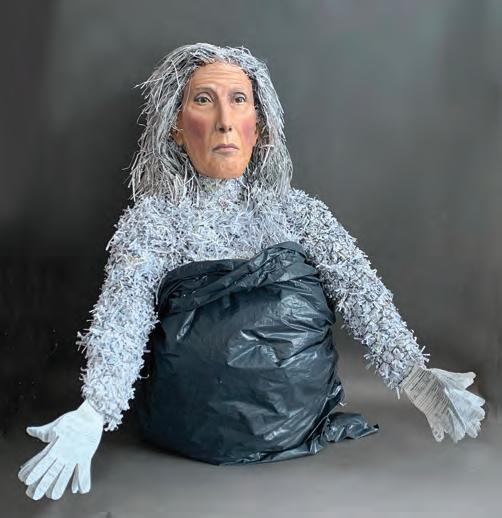
expressions. These were made with the same technique I use for my theatrical masks with plaster molds and liquid rubber cast into them. The masks are painted with acrylic. The pieces for the wooden closet frame and the base were pretty straightforward carpentry, but they had to be cut, assembled, sanded, stained, and finished with a clear topcoat. The miniature hangers that I designed were fabricated by a jeweler in silver wire.
Do you have assistants to work with you on big projects? What has been your biggest project to date?
As with The Closet, I do collaborate with other craftspeople if they have skills and techniques that I don’t have myself. For my sculpture Iris Wooed by Zephyrus, created for an exhibition at the Norman Rockwell Museum I wanted two masks supported by a swirl of steel that would suggest the wind. Iris is the goddess of the rainbow in Greek myth, and her lover Zephyrus, is god of the gentle west wind. I sculpted the masks and cast them in a material called AquaResin, but the steel support was built by NMD Ironworks in Hatfield using my sketch and a mockup I made in aluminum wire. It can take quite a bit of time and research to find the right person to fabricate what I have in mind.
When I am doing projects that are within my own skill set, I generally work alone, although I have
hired assistants when I am creating a solo exhibition and have to produce a lot of sculpture in a limited amount of time. They help with things like mold making, sanding, painting bases, and packing boxes. On some theatrical projects, actors interested in learning about mask-making have come to assist me in the studio. I greatly enjoy sharing my techniques, as well as having some company. Sometimes, having assistants also lets me design something more laborintensive than what I’d otherwise have time or budget to create.
For example, the rooster mask I built for a Double Edge Theatre production, The Grand Parade, commissioned by Arena Stage in Washington DC. The feathers were created by ripping thin strips from a piece of China silk, cutting them into short pieces, then attaching them to fabric mesh using a latch-hook designed for rug making. Each feather then had to be individually trimmed. It’s a beautiful technique, but incredibly laborious. I was delighted to have a group of student interns from Double Edge who helped me build the mask exactly as I envisioned.
My biggest project to date might be an installation titled Witness, which consists of 23 life-sized, unglazed fired ceramic heads and busts, representing a range of ages and ethnicities. They form a crowd that has gathered to watch an unknown event, though it is clear from their expressions that what is happening is powerful, eliciting anguish, tears, withdrawal,
Beckie Kravetz, The Closet
Beckie Kravetz, Overwhelmed.
The Artist in Quarentine Cleans Out Her Office

numbness — some cling to each other. Walking among the sculptures, viewers become part of the crowd, and the personal histories they bring with them inform how they interpret what might be happening. This piece emerged from the same period of deep grief that inspired All Wrung Out, a time when I was acutely aware of how people I met in social or professional situations had no idea of what was churning inside me — but I realized that I, too, might also be making inaccurate assumptions about their emotional states. I wanted to create work that made viewers ponder how our response to both life and art is a projection of our own individual experience. So this was a big project both in the number of large figures I sculpted, and in the depth of emotion they emerged from.
The mixed media element you added to the classic clay sculpture is interesting. How did you start to see the 3D part of clay go even further when you added mixed media to your work?
The use of mixed media in my work usually comes from a gut feeling more than a pre-considered design choice. I look at several different options before deciding on which (if any) embellishments to use. I know when it feels right. My Sculpted Arias series, bronze portrait masks of opera characters, included a wide variety of mixed media including sterling silver, abalone, gold leaf, mother of pearl, lapis lazuli
and malachite, as well as rubber, epoxy putty, wood veneer and paper. Operatic themes inspired the use of the luxurious elements, and the other mixed media referenced the variety of materials used to build theatrical productions.
I am looking at "Overwhelmed: The Artist in Quarantine Cleans Out Her Office." How did you create this piece, and what does it mean?
In the early days of the pandemic, like so many others I dove into some long-ignored house cleaning projects including bringing down multiple boxes of outdated tax files from the attic. Shredding services were expensive (and mostly closed), but I couldn’t just recycle them due to sensitive information, so they stayed on the floor of my office where I kept tripping over them. Realizing that the boxes were both literally and figuratively getting in the way of my doing any creative work, I decided to confront the beast by using them to create a self-portrait about how I was feeling. I bought a large shredder online and built the figure’s body using shredded papers stuffed into chicken wire. I photographed myself making an appropriately harried expression and sculpted that into an oversized mask. Except the face, every part of the figure, including the hands, is made from my old tax documents. The piece was selected for a contemporary portraiture exhibition at the D’Amour Museum of Fine Arts in Springfield. It
now looms over the dining table on our screened porch.
Do you feel you are defying rules or being rebellious with your art?
I feel that in order for sculpture to be successful it must generate an emotional response in the viewer. My husband refers to it as the gasp factor. While my work is clearly grounded in classical realism, it’s my challenge as an artist to go beyond technically mastering the figure and create moments of human connection and emotional truth. I want my sculptures to reveal something about the human condition to a contemporary audience. For me, the most exciting figurative work has an inexplicable quality that sets it apart from work that may be beautifully realistic, but without nuance or mystery. I can’t describe that quality, but I know it when I sculpt it.
As far as process goes, do you apply glazes and fire your sculpture, and do you use acrylic or oilbased paints? Painting might allow for more fine detail work. I'm curious about this in relation to the series "The Family," which piqued my interest.
I work in many materials other than clay, although pottery- or oil-based clay is always the starting point. The paint finish depends on what final material I use Continued on next page...
Double Edge Theatre: The Grande Parade. Rooster mask by Beckie Kravetz Photo credit: Maria Baranova
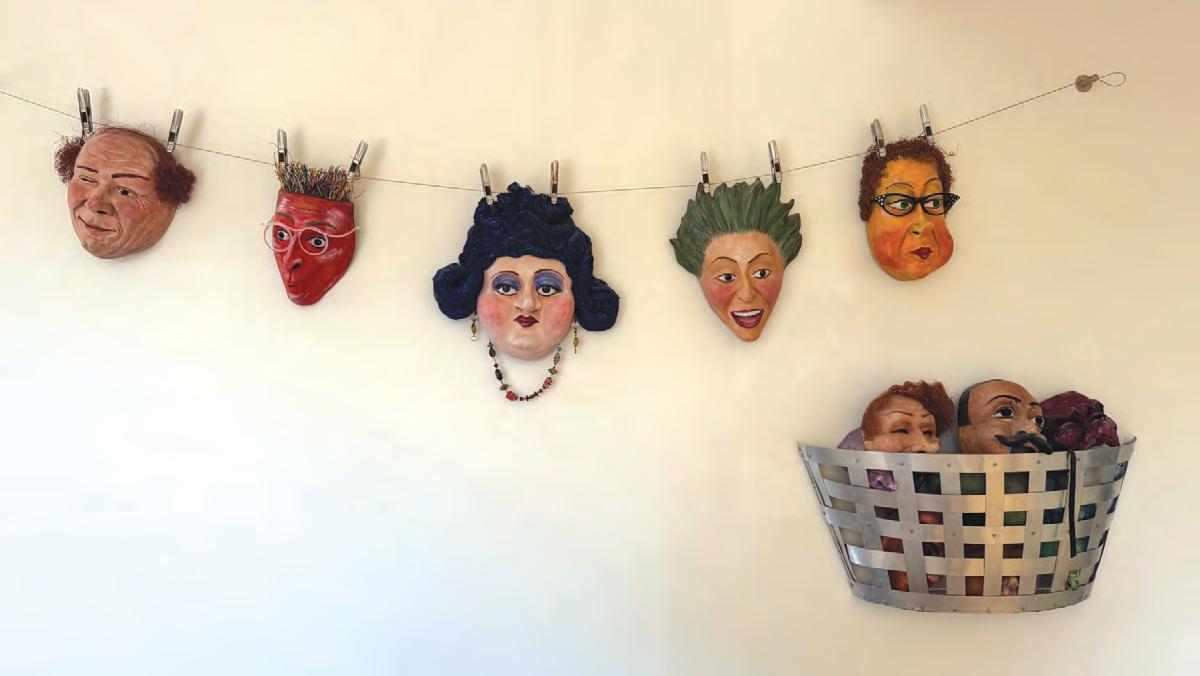
for the mask or sculpture. The Family is actually cast aluminum. The masks were sculpted in oil-based clay and cast using the lost wax process. They are painted with acrylic.
When I sculpt with pottery clay, which gets fired, I often let the clay’s natural color be the final finish. If I want to add color, I’ll sometimes use underglazes to give a base, then create layers of depth with acrylics or CeraColor, a cold-wax paint that gives a beautiful glowing surface. For masks that are realistic human faces, my technique comes directly from what I learned as a makeup artist, painting prosthetics and rubber bald-caps. I do a basecoat of a couple of different flesh tones, which I stipple with primary blue, red, and yellow to create the effect of blood vessels beneath the skin. I finish with transparent washes of the color I want for the final flesh tone.
How do you decide which sculptures to display in public settings? There are times when we create art just for ourselves, and I often wonder what steps are involved in transitioning from private work to public exhibitions. (Aside from commissioned pieces, that is.)
My public art sculptures were all created specifically for outdoor installation in public settings. Some pieces were commissioned, but I also seek out open calls that offer opportunities (and funding) to make work that will be on public view. I always enjoy watching people interact with my sculptures. I rarely create art “just for myself”. My studio work that is not commissioned is usually part of a body of sculpture that I intend to show in an exhibition — public in a different sense of the word.
So tell about your latest commissions, projects, experimental work, and any new artistic beginnings.
The past year has been happily full with commission work. My most recent project was a set of three large masks representing birds of the Chihuahuan Desert — a Gambel’s quail, a roadrunner, and a loggerhead shrike — which will be installed on swivel-jointed poles in the gardens of an educational farm in New Mexico; kids will be able to stick their faces inside and look around through birds’ eyes. I also sculpted a four-foot-high mask that’s now installed on the second-story exterior of a home in Vermont that was formerly a barn. I also created four identical masks of a king who’s the mascot of a chain of cannabis dispensaries in Michigan; a pharaoh mask for a performer in California; a devil character for a referee on the World Wide Wrestling circuit; and a giant, roly-poly, cheerful farmer who is installed outside the hardware store on Main Street here in Cummington. I am now beginning a new body of sculpture for my next solo exhibition: my deeply personal response to current world events.
Can you describe your studio time and how you balance it with your social life and family commitments?
The quest for balance is an ongoing challenge. I have two studios: masks in the basement of our house and figurative sculpture in an outbuilding. I love working from home but also find it hard not to let household responsibilities interfere with studio time. I tend to deal with desk or household tasks after breakfast and don’t start in the studio until late morning early afternoon, then tend to stay at work fairly late, especially during summer’s long days. My husband is a writer and on a similar schedule, so we often don’t sit down to dinner until after 8PM. We do attend social and cultural events, to make sure we have a life outside of our work.
How have today's social and political issues influenced your beliefs and perspectives as an artist? Tell us just enough so we get you.
As I mentioned before, the body of work that I am just diving into is a response to what is going on in the world right now. Social and political issues have not so much influenced my beliefs and perspectives as my need to make sculpture and public art about them. Most of my previous work has either responded to personal events or to music that has touched me deeply, particularly opera music. This new body of work will not, I think, be overtly political, but will address the environmental and societal repercussions of human activity in general and the current administration in particular.
What is your ‘Me Time’ all about? Do you feel that taking breaks to do other activities improves your focus when you return to the studio?
It is easy for me to get lost in obsessive detail when I work, completely losing track of time. But on the flipside, I tend to have several projects going on at once in the studio and sometimes when I’m walking over to get a tool for one piece, my attention gets distracted by a project on a different sculpting stand. When I need to refocus, taking a break definitely helps. In the summer, “Me Time” is all about the garden, but in any season, just stepping outside to be in nature — we live in a rural setting surrounded by woods — listening to the birds and observing what’s going on around me is both inspiration and solace. Cooking and baking also offer welcome breaks from work.
From your art teaching, what principles are the main ideas you tell all your students to remember and follow?
Everyone is an artist, and art has no right answers.
Beckie Kravetz, The Family


What challenges and conflicts are you continuously wrestling with? Perhaps we can all relate to the ones you can share, as the universal artist within us often does.
As I mentioned before, time management and work/life balance are ongoing challenges. I also fight, as many artists do, the worry that I won’t be able to make my hands do what my mind sees. But I know the answer to that is not stress about it, but just to get in the studio and let my hands do what they know how to do.
By the way, where did you grow up? Was art a staple during your childhood? Give us a picture of what you were like back then. I grew up in Phoenix, Arizona. I moved there in 1962 when I was three years old and Phoenix was pretty much still a cow town, with only one movie theater and one live theater where roadshows would come in. My dad loved the desert and the outdoors, but it was quite a shock for my mom, who grew up in New York City going to Broadway and museums and concerts. Phoenix did have an art museum, which I was

taken to frequently, and the museum offered kids art workshops, which my parents were eager to have me participate in. The city also had a great children’s theater and I both attended and acted in performances from a very young age. I was taken to Phoenix Symphony concerts and started playing cello when I was 11. I was the youngest member of the Arizona Cello Society, a rather incredible gathering of 60 cellists. I got to be in a concert where Pablo Casals played and conducted, though he was 94 at the time and pretty frail, but still, a very special experience. My mom always loved the opera and listen to the radio broadcast every Saturday, but truth be told, as a child, I didn’t like it at all and would just leave the house when the opera was on. It was a great gift for both of us when I fell in love with the art form and we could share it.
How much does your spirituality affect your life as an artist?
My spiritual life is focused on being in nature. I grew up Jewish, but don’t practice organized religion. I think my connection to the natural world has a profound impact on my life as an artist, starting very
with the
What do you feel truly blessed about and fortunate to have?
A wonderful, loving, and supportive husband. A beautiful home in a beautiful place. Excellent health. Deep family and friend connections, both nearby and around the world. Having had the opportunity to travel extensively. The security of shelter, food, and a supportive community. Growing up in a family that appreciated and nurtured my artistic inclinations. The incredible gift of living life as an artist.
beckie@bksculpturestudio.com
simply
joy of having my hands in clay.
Beckie Kravetz, Witness. Installation. Photo credit: David Stansbury
Beckie Kravetz, Iris Wooed by Zephyrus
Beckie Kravetz, Siegmund and Sieglinde

JULIA GREY
Julia Grey has spent the last twenty years training, photographing and painting hummingbirds; both in the Berkshires and in Las Vegas, NV. They are her great loves.
Ms. Julia Grey — She/Her/Miss www.xgender.net

LEO MAZZEO
As a long time advocate for the arts, New Ashford based artist Leo Mazzeo has served on regional boards and acted as a catalyst for many arts related projects. He works primarily on paper, using diverse media and techniques appropriate for each piece’s theme. Initially, he establishes a broad concept, which evolves into a narrative as a piece progresses.
Mazzeo sketches from life, reference images, and imagination, assembling compositions almost as a collage artist would. Symbolism is key, and characters and objects often have repeating roles. His themes are sociopolitical/psychological, often surreal, reflecting personal perspectives and offering therapeutic benefits.
Leo Mazzeo — l-mazzeo@hotmail.com
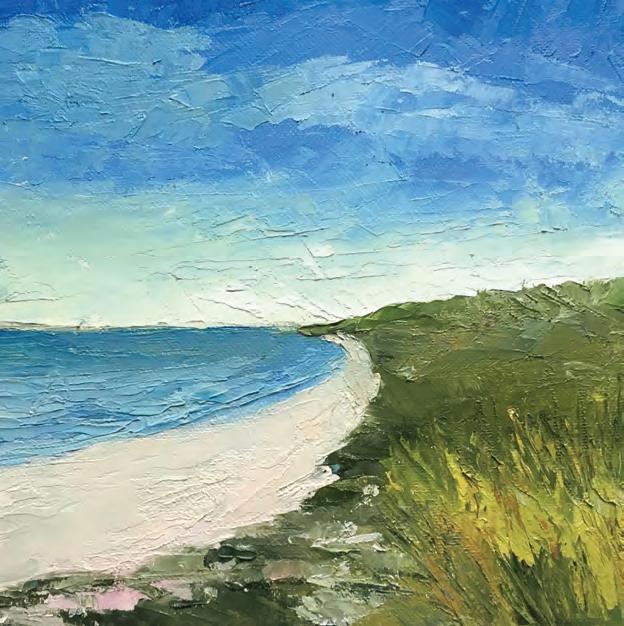

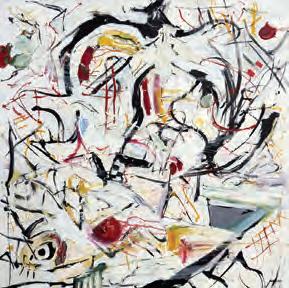
KATHERINE BORKOWSKI-BYRNE
I studied painting at the Boston Museum School of Fine Arts when painting was king. It was when I first saw a deKooning painting, that I knew what painting could do and that I had to be a painter.
My main love is oil on canvas or paper giving the full range of marks from watery thin to luscious thick. One of my favorite teachers at art school, said, “When you paint in oils, you have the whole orchestra.”
My inspiration comes from many outside sources but my excitement comes from the process of painting when any original ideas disappear and the painting has a life of its own. My favorite pieces are those that come from “within.”
Katherine Borkowski-Byrne — www.katherineborkowski-byrne.com artborkowski@aol.com
"MOHAWK WITH COLUMBINE"


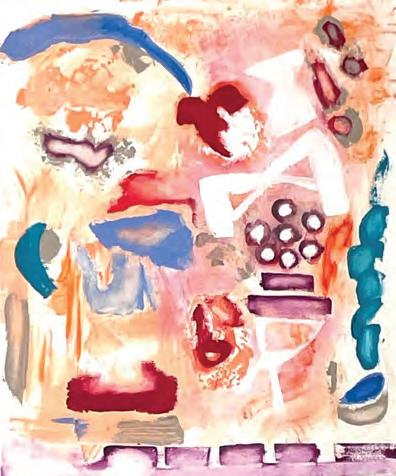
Fire
rdaver2@gmail.com | Instagram: rdaver2. Housatonic Studio open by appointment: 413-854-7007

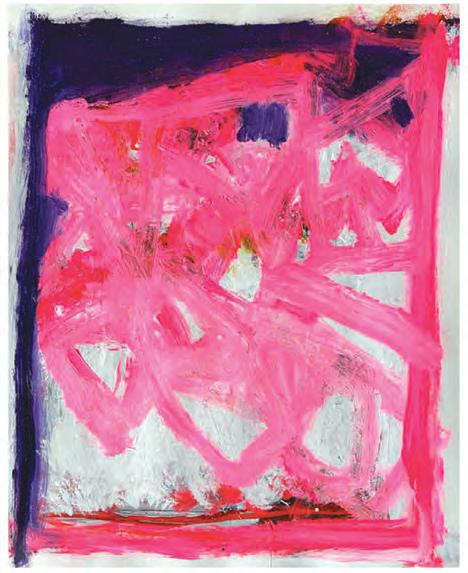
BRUCE LAIRD


Business Center Studio #307
75 South Church Street, Pittsfield, MA Instagram- ecurbart
Clock Tower Artists
Carolyn M. Abrams
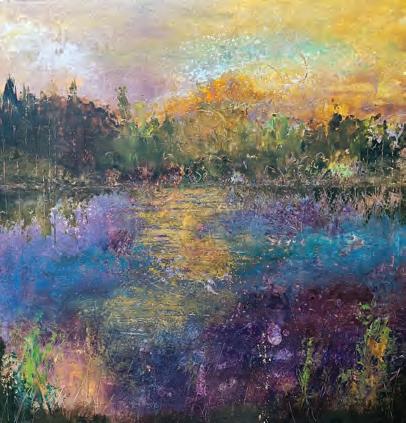

“Portrait of the Artist as a Child” by elizabeth cassidy
Portrait of the artist as a child. Would you please write? Write anything. I clutched my crayons and declared I do not like letters.
I do not know where the letters go. The colors that complemented my world Were overlooked because I did not know Where commas went to live on the page.
Portrait of the artist as a child. Would I please stand still?
Could you get the world to stop moving, too? Neither of us could rest.
My limbs were under the spell
Of dancing fairies who pleaded with me
To show them how to twirl around the garden Without wings.
Portrait of the artist as a child. Would you not run out of the classroom Before lunchtime?
But there was a playground with so much excitement To behold.
And not a single child to push me off the seesaw.
Portrait of the artist as a child.
FRONT STREET GALLERY

Incoming Block Island Ferry Rough Seas 20x20” Oil on canvas
Painting classes on Monday and Wednesday Mornings 10-1pm at the studio in Housatonic and Thursday mornings 10am - 1pm out in the field. Also available for private critiques. Open to all. Please come paint with us!
Gallery hours: Open by chance and by appointment anytime 413. 274. 6607 (gallery) 413. 429. 7141 (cell) 413. 528. 9546 (home) www.kateknappartist.com Front Street, Housatonic, MA
Would this school had been able to help you?
Would Charles Dickens have dared to enter?
Trying to silence me
Back then only forced me to realize I know where letters go.
Putting vowels and consonants together
Created my voice. A very good voice.
Albeit a tad loud at times.
Portrait of the artist as a child.
Do you know what a brush
Felt like when I wrapped my fingers around it?
How clay cushioned my hands
Against a cruel world.
And how a charcoal stick glided across the paper
Like an ice skater on their way to the Olympics.
Portrait of the artist as a child.
I had dreams that if I met Leonardo Da Vinci He would insist that I call him “Lenny.”
Truthfully, I got one of those smiles
You just cannot forget.
@2025 elizabeth cassidy
elizabeth cassidy studio works artist, illustrator, writer, poet, peace lover
elizabethcassidystudioworks.com

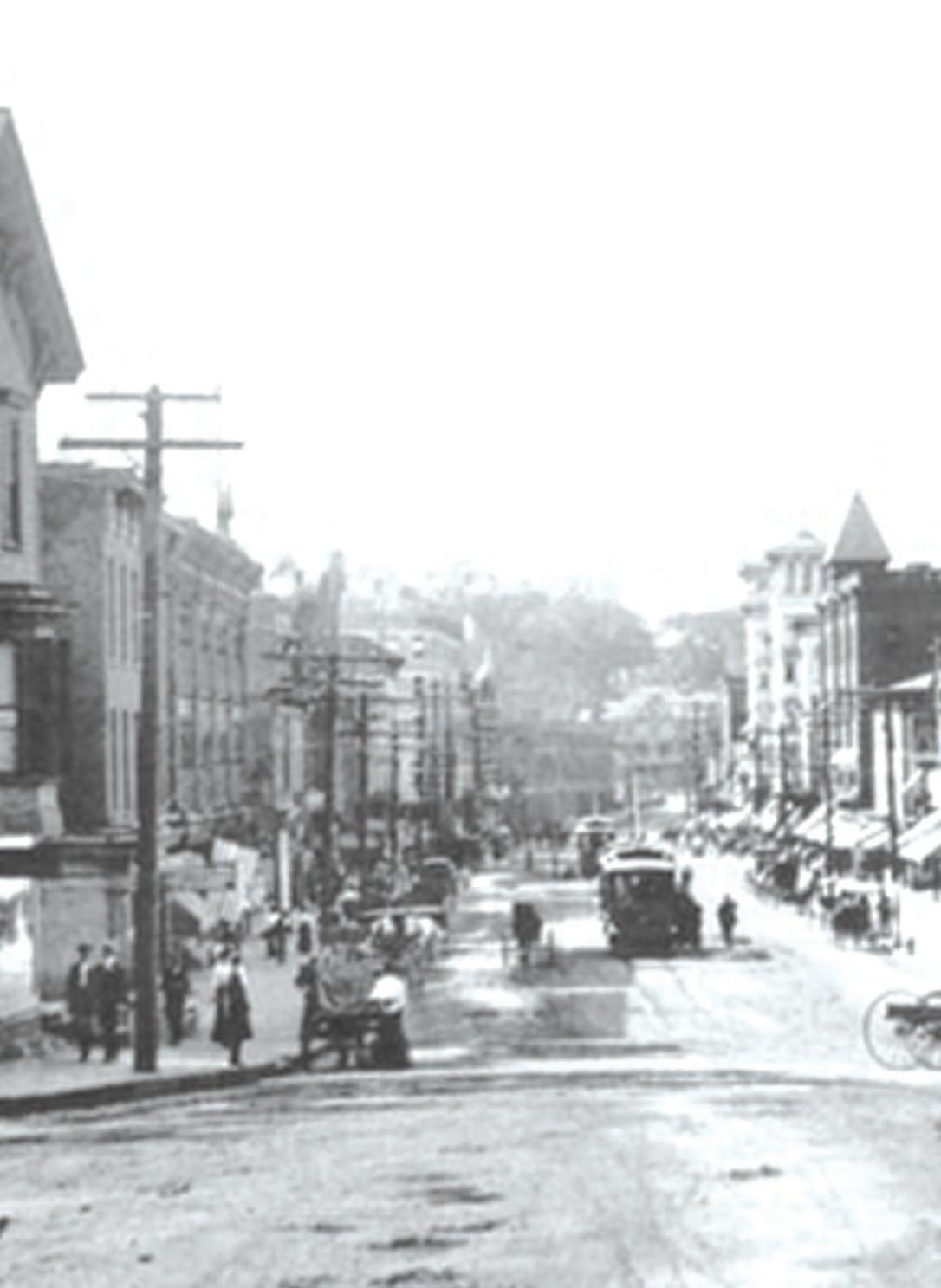
“In Good Company.”
The Artful Mind Fine Art Exhibit
Reception for the Artists
Saturday August 9TH 5 - 8pm
Jaye Alison
Ruby Aver
Richard Britell
Katherine Borkowski-Byrne
Margaret Buchte
Leslee Carsewell
Janet Cooper
Candace Eaton
Yana van Dyke
Jane Gennaro
Susan Gilbert
Julia Grey
Ghetta Hirsch
Sarah Horne
Ellen Kaiden
Stephan Marc Klein
Beckie Kravetz
Bruce Laird
Pattie Lipman


Leo Mazzeo
Jesse Tobin McCauley
Bobby Miller
Richard Nelson
Janet Pumphrey
Ilene Richard
Alexandra Rozenman
Richard Talbert
Scott Taylor
Jay Tobin
Mary Ann Yarmosky
11 Eagle St • north adams MA.
HOURS: WED - SUN Noon - 4:30 pm and by appointment
Note: Please call ahead if you are coming from a distance.



WARREN STREET GALLERY, Hudson NY now offering Vintage Delevingne silver prints for these times
artschool99somerville.com www.alexandrarozenman.com alexandra.rozenman@gmail.com

| www.JanetPumphrey.com

https://www.instagram.com/Lioneldelevingne http://www.lioneldelevingne.com/ http://www.510WarrenStreetGallery.com

Yellow Jacket Under the Sun, Oil on canvas,
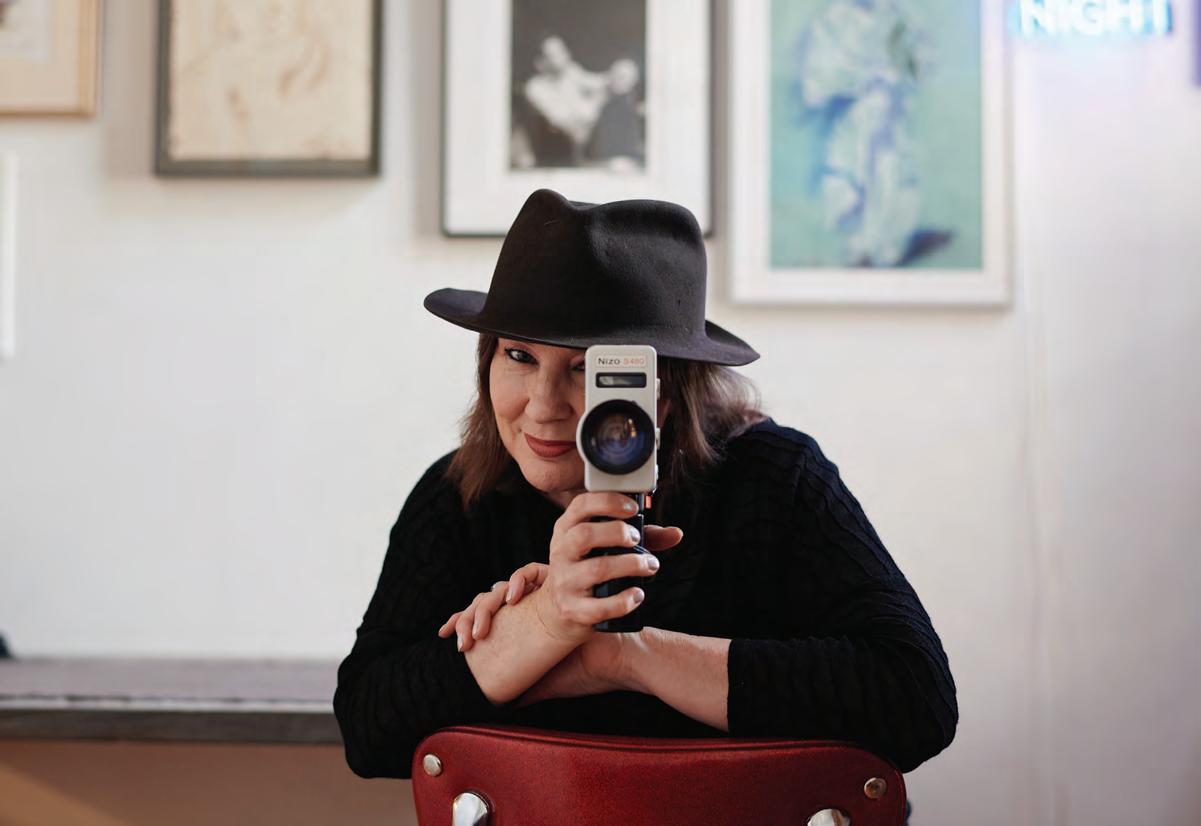
IMELDA O’REILLY FILMMAKER
“Embarking on a new work often involves mystery. In my independent filmmaking process, I strive to take risks and to discover the poetic truth beneath the images.” —IMELDA O’REILLY
Interview compiled/created by Imelda O’Reilly and Harryet Candee Photographs by Rachel Neville and courtesy of the Artist
Imelda O’Reilly’s filmmaking practice blends genres and fuses disciplines across poetry, playwriting, fiction, and dance. She has a unique voice inspired by art films, animation, the avant-garde, and the old bards of Ireland, not to mention filmmakers such as David Lynch, Lucretia Martel and Andrei Tarkovsky. Her approach to the artistic process conjures a trippy blend of animation, live action, drama, surrealism and a little humor. According to Richard Propes of the Independent Critic O’Reilly’s short narrative film Suspicious Minds offers all of that plus “an abundance of heart and a musical sequence that you can’t help but fall in love with. The end result is one of 2024’s most engaging and uniquely realized short film experiences.”
Where did you grow up, and how did it influence your life in the arts?
Imelda O’Reilly: I am an Irish-born interdisciplinary
artist part rebel, part nomad. I dreamed myself out of County Kildare at a young age. All my generation left Ireland for London, Australia, New York and Boston as there was a lot of economic hardship when I was growing up. Young people would flee Ireland to seek work and a better life. I had a very active imagination and persisted in trying to find an outlet for my ideas.
My first foray into the arts began with dance and poetry. At 7, I was home with my grandmother Winifred Caffrey and decided to put on a play for the locals. For the stage, I found a piece of wood and placed it across my twin pram (baby carriage). I cut up cereal boxes and made puppets with popsicle sticks. I imagined a story and wrote a script for my play. In addition to putting on a show, I made and sold popsicles to the neighboring children. They gleefully sucked on popsicles while watching attentively. I charged an entrance fee of tuppence ( 2
cents) for the production. That was my first paid gig as a director.
During this time, I wrote a poem titled “Have a Go Girl”, and it got published in a Jinty comic. I remember my excitement when a check arrived in the post for the amount of 5 British pounds. I thought I’d continue to dabble in scribbling!
What was the first film you saw at the cinema?
My introduction to film was at the Oscar Cinema in Newbridge, where my aunt took me to a double bill of a British B movie titled On the Buses and a Vincent Price movie, Theatre of Blood. I developed a love of film and grew up watching the old classics such as The Sweet Smell of Success, Notorious and Lawrence of Arabia with Peter O’Toole.
Did any of your family emigrate?
My immediate family never left the rock i.e., Ireland.
Photo credit: Rachel Neville

However, my Aunt Betty left in the 1950’s on a boat and still lives in New York City. I was initially raised in a thatched cottage in Karna, County Kildare. It had a well and a stream outside. The well had a small wooden trap door. Despite it being tiny, I perceived it as a child to be larger than life. I remember fearing I would fall into the deep, dark hole.
Ireland was predominantly Catholic, and I wasn’t cut out for a Catholic education. I tried to escape the culture of the church through art. I come from a family of five siblings and living in the countryside with such a large family inspired the writer in me. Also, my grandfather Edward Caffrey, who lived with us, dabbled in writing and encouraged me to explore language.
Dancing and music are an important part of Irish culture, and I first became acquainted with performance through dance. My father John O’Reilly’s, family are champion Irish dancers, and I took Irish dance classes from a young age. I competed in an Irish Féis for medals and plaques. At the time, I didn’t love Irish dancing because it wasn’t cool back then. It was much more straight-forward: a pair of pommes and a costume.
Ireland had lots of political conflict. Can you speak to how that affected you?
This was a time in Ireland when “the Troubles” were at their height. There was violent sectarian conflict in Northern Ireland between the Catholics and the Protestants over six counties that had remained under British rule. The Protestants wanted the province to
remain loyal to the United Kingdom, and the Catholics wanted Northern Ireland to become part of the Irish Republic. There were murders, bombings, kidnappings. I remember when Tiede Herrema, a Dutch businessman, was kidnapped by the IRA. They held him hostage for six weeks - and this was only miles from where I lived. This awakened me to the violence and politics within my country. To escape this tyranny, I dove deeper into my imagination.
How did moving to New York influence your work?
I moved to New York at 18 and went to college. After graduation, I began acting and working with companies such as Ensemble Studio Theatre and the experimental theatre company Mabou Mines. I studied Meisner technique with Mary Doyle, who became a mentor for me. I explored acting for a few years, and eventually became more interested in writing and directing. Ruth Maleczech, founding co-artistic director at Mabou Mines, and Isaiah Sheffer, artistic director of Symphony Space, were very supportive in those early days.
Ruth awarded me my first artist residency at Mabou Mines, and my play Faz In Ate was produced at the CSV Theatre on the Lower East Side. It was about a brother and sister who dream themselves out of despair by creating this imaginary world called Faz In Ate, where Mr. Zing speaks an invented language called zing talk. Developed through Mabou Mines and produced by Deadalus Theatre Company, it played at the Clemente Soto Vélez Cultural Center.
This play was very avant-garde. Only an experimental theater company such as Mabou Mines could appreciate such work.
At Symphony Space, Isaiah featured me in Bloomsday on Broadway as a poet reading my poem titled Emilita and the Fairy Glen
In 2007, Ruth commissioned me and four other female poets to write poems about each of the New York City’s boroughs entitled Song For New York: What Women Do While Men Sit Kitting and produced by Mabou Mines. I wrote the Staten Island poem. The piece was workshopped at the Sundance Theater Lab, and Vassar College through New York Theater Workshop and eventually performed at Long Island City’s Gantry State Park on a barge with New York skyline as a backdrop. The audience was on land, the actors were on water and, the play was reviewed by the New York Times.
Meanwhile in 2000, I had received a fellowship from New York Foundation for the Arts for my poetry. I was simultaneously commissioned the following year by Deadalus Theatre Company to produce my play Emilita and the Fairy Glen. New York fostered me as a young artist, helping me find my place in the arts and develop my voice.
As a female artist, how did you find other artists to collaborate with?
I was involved with a group of Irish women named Banshee who included, Emer Martin, Helena Mulkerns, Elizabeth White, Caitriona O’Leary and Darragh Carr. Continued on next page...
Illustration of Emilita and the Fairy Glen drawn by Charles Chaisson
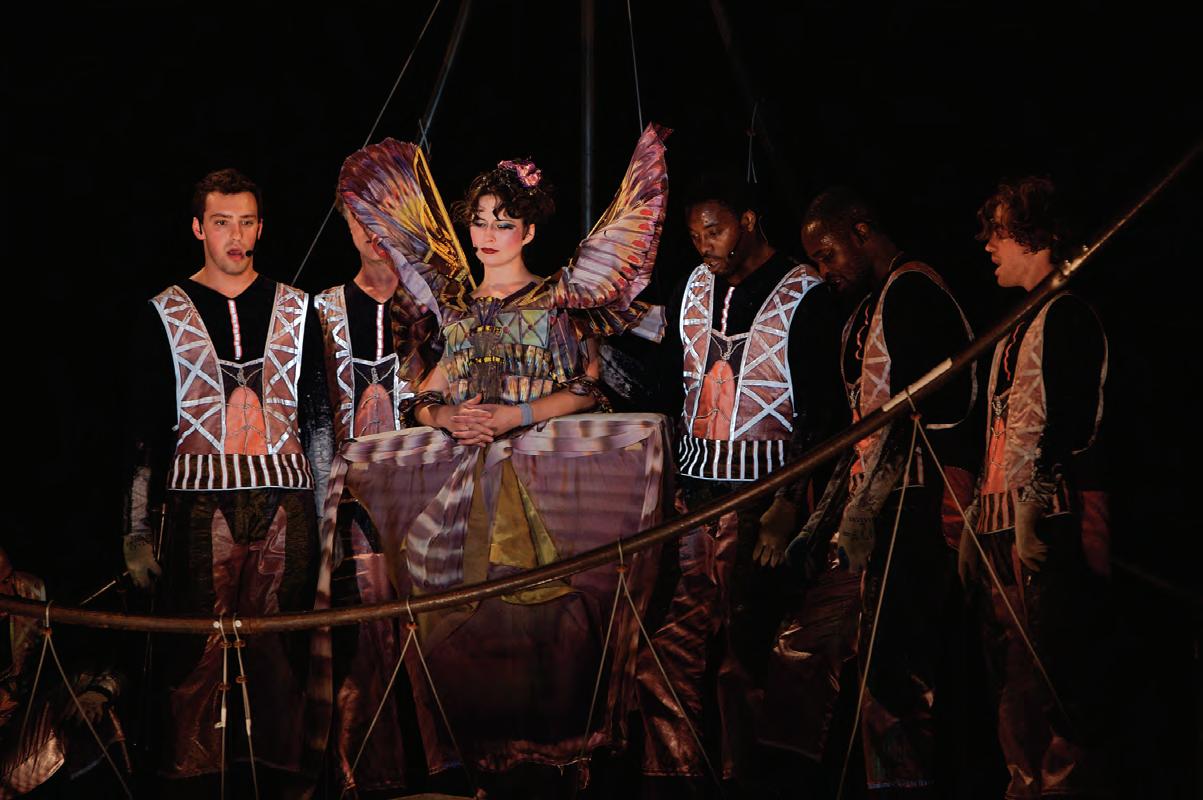
We formed a collective when the internet came out to help promote one another’s work. We all had different disciplines: a poet, a dancer, a singer, a novelist and a short story writer. We performed at the Fleadh Festival on Randall’s Island with Sinead O’Connor and Shane MacGowan. We collectively called this creative time “the banquet years.”
New York had a thriving arts scene in the ‘90s and this came with a big community. We all had different dreams and were probing the streets to find our kind of gold. That meant living in the East Village, working in survival jobs to pay rent while simultaneously pursuing our artistic goals. A documentary was produced about Banshee, and we were interviewed by the Village Voice, which called us “The Vice Girls.” There was a certain freedom and risk taking at that time in New York City art. It recalled the culture of Gertrude’s Stein’s Paris apartment and salon. We in Banshee were all hustling-the Irish diaspora trying to find our voices and feel connected while being so far away from home.
How does travel inform your creative lifestyle?
Travel fuels my creativity. To date, I have lived on four continents: Europe, Africa, Asia and North America. After my housing situation fell through in NYC, I moved to Paris to study French and follow in the footsteps of Beckett and Joyce. While studying French, I pursued the ghosts of so many famous artists and writers who had lived in Paris. It gave me
the space and time to delve further into my artistic impulses. I produced an event I called Bloomsday Jaunt after Joyce’s novel Ulysses; Leopold Bloom is a character in the book; his birthday is on June 16th and this event is celebrated worldwide. We began in the morning at the James Joyce pub and in the afternoon read Ulysses outside Shakespeare and Company, dressed in 19th Century costumes outside the bookshop where Ulysses was first published by Sylvia Beach. We ended up at the Finnegan’s Wake bar in the evening.
Recently, I was interviewed by Keri Walsh, a history professor at Fordham University, for a book she is currently writing about the history of the Shakespeare and Company bookstore. (George Whitman established his own bookstore in Paris and named it Shakespeare and Company after the original store Beach had founded.) The interview stirred what I call a “pocket memory.” As I was recalling the person I spoke to initially regarding the Bloomsday Jaunt, an image came to my mind. I asked Keri if Whitman has blue eyes, a gentle nature and straight brown hair and wears a tweed jacket? “Yes!” she replied enthusiastically. I left Paris to pursue acting and poetry via Edinburgh. Then I landed in London a down-and-out artist. A friend in Croydon let me sleep on her couch until I got on my feet.
You’ve collaborated with a lot of artists, not least musicians. How does music inform your process?
I love music and have collaborated with musicians since I began performing my poetry in London. This included recording an album titled In People’s Heads, an album with composer Joel Diamond. More recently, I have had several poems released on Composer’s Concordance Records entitled Under the Wolf’s Cloak and Sound Liberation’s Elegy, which contains a live reading at New York’s Joe’s Pub of my poem Ham Sandwiches at the Holiday Inn.
Under the Wolf’s Cloak is a rewritten feminist version of Little Red Riding Hood. I have always been drawn to the power fairy tales and chose to envision this tale as a feminist narrative. We shot this as a 360 virtual reality film and screened it at the John C. Wells Planetarium at James Madison University in Harrisonburg, VA. The piece was then produced as a staged play at JMU’s Forbes Center. In December 2024 the film premiered in a 16 x 9 version at the Westbeth Artists Community in Manhattan, with live music and live narration. Like poetry, dance, music and song, music has rhythm: once you connect to it , a piece will play itself. When I was reading Molly Bloom’s soliloquy in Paris, director and artist Bob Myers suggest that whenever I said the oft-repeated “Yes” I should hold on it for three seconds. This direction helped Joyce’s soliloquy play like a piece of music.
I also premiered Women with Irons in Kitchens, an homage to all the mothers and wives who labored at
Photo Staten Island Poem from Mabou Mine’s Song For New York (2007) Photo courtesy of the Artist

motherhood and housework, at Filthy McNasty’s Whiskey Café in London. Owner Gerry O’Boyle had launched Vox n’ Voll a program to fuse literature with music. Following the success of Women with Irons in Kitchens, Gerry would summon me to read late at night, a process that inspired such other works as Ham Sandwiches at the Holiday Inn and Fabio-recently performed in New York with Composer’s Concordance at Joe’s Pub and Birdland, respectively.
Do you consider art a dialogue?
All art is a dialogue. I am often inspired or feel drawn to respond to other works of art, be it a painting, a resuscitation of a poem, a song, a sculpture, a novel or short story. That is the fun of collaborating, and what eventually drew me from theater to film, was that I had a bigger canvas to play on. In Ireland a resuscitation is part of the culture: when we were invaded by the British, schools were banned and storytelling was passed on through songs. This invariably became part of the Irish trad seisiún in pubs. I have collaborated with musicians, composers, actors, writers, dancers, choreographers, cinematographers, animators, novelists, painters, poets, and filmmakers. This is integral to my artistic process. I love the community film attracts. Most recently, I collaborated with the late Chuck Connelly before he passed. I was commissioned to write a poem about his painting of David Bowie. I performed with Composer’s Concordance at Chuck’s house in Philly last
September. It was incredible to chat with him and pay homage to his impressive body of work.
Where do stories come from?
Stories or ideas come in fragments, they often don’t come all at once. To quote David Lynch “You have to catch ideas, it’s like fishing.” They come from mysterious places: a smell, a song, an image, but often it’s an idea that stays with you and doesn’t go away. Those are the stories, the ones to pursue. When I was younger, I had an incessant need to write continuously in my practice. I would write dailies, like a diary, discarding all my self-doubt for the day. At the time this was helpful and aided me, but as you mature and progress your patterns and artistic habits change. They form new practices - a deeper fluency. That is what makes the artistic journey fun.
How do you fund your projects?
Funding can be challenging. You have to think outside the box, and it does involve some kind of luck. In 2000, I received a New York Foundation for the Arts Grant for poetry, and I decided to fly to Morocco on September 11th, 2001, to write my first novel. I had been living in the East Village prior to this and once again, I encountered my nomadic bug alongside a premonition that something bad was about to take place. I had this bout of intercontinental restlessness and knew instinctively that I had to flee Gotham. I spent six months between Asilah, Morocco, and Se-
villa, Spain working on a novel titled Plastic Nation. It was as stream-of-consciousness novel that was written through allegory. I’ve observed that in my practice I was consumed with writing daily. And that I did: I produced 250 pages of a novel. I wanted to prove I could do it. However, in my later years, I find that the writing unfolds in my subconscious and the story manifests differently. The actual physical writing part of the process now absorbs the least amount of time. It’s an entirely different way of working. It's different for everyone. You become more embedded in your own individual artistic practice.
Poems for me have always been blueprints for larger ideas. They are economic in nature, so if I have a larger idea, I script it out as a poem and then it develops further. Poems are closer to screenplays than novels, as they are more economic. I had my first chapbook published out of Northern Ireland by Lapwing Press, titled I Wake in Half Dream in 2000. Feature screenplays include Beneath the Boy’s Cry, and We’re the Kids in America, which was an official selection for the Cannes International Film Festival in 2018. My producer Barbara DeFina has been a huge mentor for me in the industry, and also Tom Kalin. I met both while I was a graduate student at Columbia University. My fiction has appeared in Shenanigans, published by Sceptre in the UK. More recently, a short story titled Fez appeared in Cassandra Voices. I have had ideas for installations but never had the opportunity to realize them. Continued on next page...
Imelda O’Reilly center in Paris in 1999 outside Shakespeare and Company bookstore.

In 2008, I was awarded a Fulbright Fellowship to Morocco. This provided funding for fifteen fifteen months. I received a critical language enhancement award to study Darija, a colloquial version of Arabic in Morocco, as well as a nine-month Fulbright Fellowship. I was completing my M.F.A. in film at Columbia University. I landed in the ancient city of Fez, a World Heritage site. Studying Darija was challenging, so every evening after a full day of classes I would walk home from the new town to the ancient medina. While sitting on my roof top, I began scribbling these poems. Little did I know that these poems would become part of my thesis film, Bricks, Beds and Sheep’s Heads, about a Moroccan immigrant looking back on his life on Aid El Kebir, a big festival day. The beauty of the film is that it immersed me into the local community. When I completed it, we screened it on my rooftop for the locals. It deepened my relationship to Morocco. I still have Moroccans reach out to me today on the Aid holiday. The film was nominated for a student academy award. As an Irish immigrant, I can relate to Moroccan immigrants. We filmed a real sheep sacrifice in the film as part of the L’Aid El Kebir. This culture is in touch with where its meat comes from. I was a female westerner living in a Moslem country. Being immersed in a country with multiple languages is a gift, and Moroccans speak so many languages. It’s impressive: Darija, French, Berber, English and often, Spanish.
The film was a hybrid film, part fiction, part doc-
umentary. When we were filming, the butcher character in the film later that evening looked upset one evening. When I asked him what was wrong, he replied that his sister had just died. It was upsetting. The film juxtaposed an imposed death (the sacrifice of a sheep) alongside a natural death, (the passing of his sister.) Inevitably, this became part of the narrative in my film. This film process was unlike any other. Looking back, I see that it’s because I was interacting with my environment - with a culture completely new and unique to me. I had to reinvent my working process, take risks and discover a new way of making what’s called a hybrid film.
The US ambassador to Morocco at the time, John T. Reilly, came to the academic conference for the Fulbright mid-way through the fellowship. Many Moroccan academics had a negative reaction when they saw my film, even though it portrayed their culture in a positive light. They were concerned how Westerners would perceive their country and culture. The ambassador stood up and defended the film, emphasizing that it honored their culture. In fact, he invited me to his house and hosted a private screening of the film.
Two years later, I screened Bricks, Beds and Sheep’s Heads in New York City at the Arabic Center, and the Moroccans who had left Morocco had an entirely different reaction to the film. They recognized it was honoring their culture. In fact, they thought it to be a true account despite the story being fictional.
It was reassuring that Moroccans who had moved
away understood the film. There is a certain mystery involved every time you make a film. It’s an almost unsurmountable task, so it’s a miracle any time a film gets completed. My hybrid Moroccan film was a hybrid film and was seminal in my breaking new ground as a filmmaker, capturing a truthful portrayal of a culture. Living in Morocco for 15 months and studying Darija fundamentally gave me a new perspective on life and changed my outlook on both life and art. Living in an ancient walled in city and engaging with the locals let me discover my kind of gold.
How does teaching inform your artistic process? Teaching is also a part of my filmmaking practice. I was an assistant arts professor for New York University’s Graduate Film Program in Singapore for three years, and I got to travel all around Asia. I am based in New York City and I am currently an associate professor of film at James Madison University. It’s fun to mentor young filmmakers into the industry. Being around their passion and energy is always an inspiration. In many ways, teaching is like directing. Leading students through the problem-solving process and away from previously developed bad habits, I try to guide them to work in a more enlightened way. I am also the director of a filmmaking workshop in Morocco, at the American Arts Center in Casablanca, where I mentor young Moroccan filmmakers on making films. Last year I was a visiting artist, and they screened a number of my films.
Under the Wolf’s Cloak at the Forbes Center, James Madison University Photo credit: Richard Finkelstein
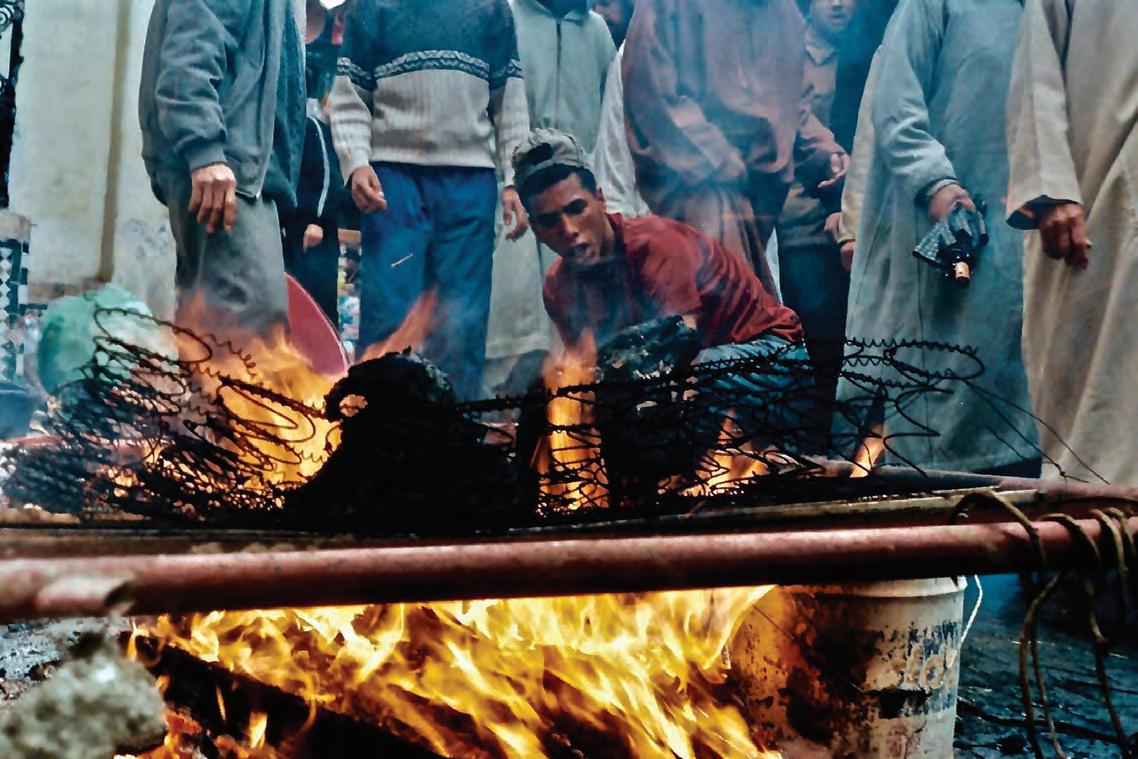
There is a certain relationship with mystery in the creation of art. Can you speak to that? Embarking on a new work often involves mystery. In my independent filmmaking process, I strive to take risks and to discover the poetic truth beneath the images. Often you need three things to make a film: time, imagination and money. Frequently, you don’t have all three of those things, but you might have two. Every film or project evolves differently. It begins with a driving passion and progresses and shifts to shape a structure. You need a location to work from, whether it’s a residency or someone’s house. Often a unifying image can emerge to help anchor the film’s central idea or theme.
During the pandemic, I recalled my cousin’s visit from America when I was about 9 years old. She brought some friends, the Lindsays, with her and they stayed in our house. When they returned to New York, they sent a parcel gifting us a cassette player and a cassette tape of Elvis Presley’s The Sun Sessions. I recall my mother Helen playing it over and over in the cassette player of our car. I was also remembered King of the Fairies the first hard shoe Irish dance I had learned. I took these two images - the Irish dance and an Elvis Presley song - and structured a story around them. This developed into a screenplay titled Suspicious Minds
When I submitted the script to the Catwalk Art Residency in Hudson, NY., luckily, they chose my project. (The production of a film can often involves a certain amount of luck.) They provided a location
and accommodation for my actors and crew so I could shoot on location as an artist in residence. Additional locations for Suspicious Minds included a Cill Rialaigh Residency the following year in County Kerry, Ireland, and some shooting on location in the Portarlington bog in County Kildare. When we filmed in Ireland on the bog, I had my younger cousin dancing a traditional step-dance titled King of the Fairies. I grew up footing turf on the bog with my uncles. (Turf is a peat that Irish people use as fuel for fires). The bogs are a huge part of Irish culture and since we joined, the EU has been attempting to shut down exploitation of the bogs because of global warming.
Seeing my younger cousin dancing the King of the Fairies on the bog, dressed as Dorothy from the Wizard of Oz, was a true blending of Irish and American cultures. I got quite emotional. This is the mystery of art: You experience a connection and imagine a project. Often you don’t fully understand your journey, but then in a surreal moment you discover a unifying image that represents your whole movie. These moments are the true gems.
A bystander who was footing turf on the bog that day also ended up being in our film. He could have been one of my uncles. Instantly, I felt a deep connection with my family and my ancestors. These are the moments that keep me rooted in the pursuing of an artistic path. It’s not about money or success but something deeply personal and private, a mysterious conversation with the medium itself. Ireland has had
a long-standing relationship with America, because so many Irish people have immigrated. There are strong ties between Ireland and the US.
In this film, I also combined live footage and animation, which required advance discussions about how to integrate these two different aesthetics. I like long lenses and try to contain my locations, as moving can be costly. I love working with actors and give them the freedom to explore the characters. I also like mixing non-actors with actors. It can create an interesting dynamic.
For me, filmmaking is a journey to the edge – exploring a character’s relationship to mystery, observing ritualistic habits, nuances, understanding why they manifest conflict. Cinema deepens the poetic truth beneath the images.
Can you discuss how you work with actors?
One scene from Suspicious Minds was challenging because we were shooting in a large forest, and it can be challenging to create structured scenes within a wide-open space. I discovered a beautiful fallen tree that had fallen and it reminded me of the trees in the film Pan’s Labyrinth. I had this idea to have actress Gina Costigan the actress climb the tree and dressed as Dorothy from the Wizard of Oz, and wearing the famous shiny, red shoes. There was also a campfire in this scene. So, I choreographed the scene around the fallen tree. Although challenging, it worked. For an artist, it’s a wonderful feeling when things work. Continued on next page...
Shooting on location in Morocco for Bricks, Beds and Sheep’s Heads (2008) Photo credit: Joe Foley

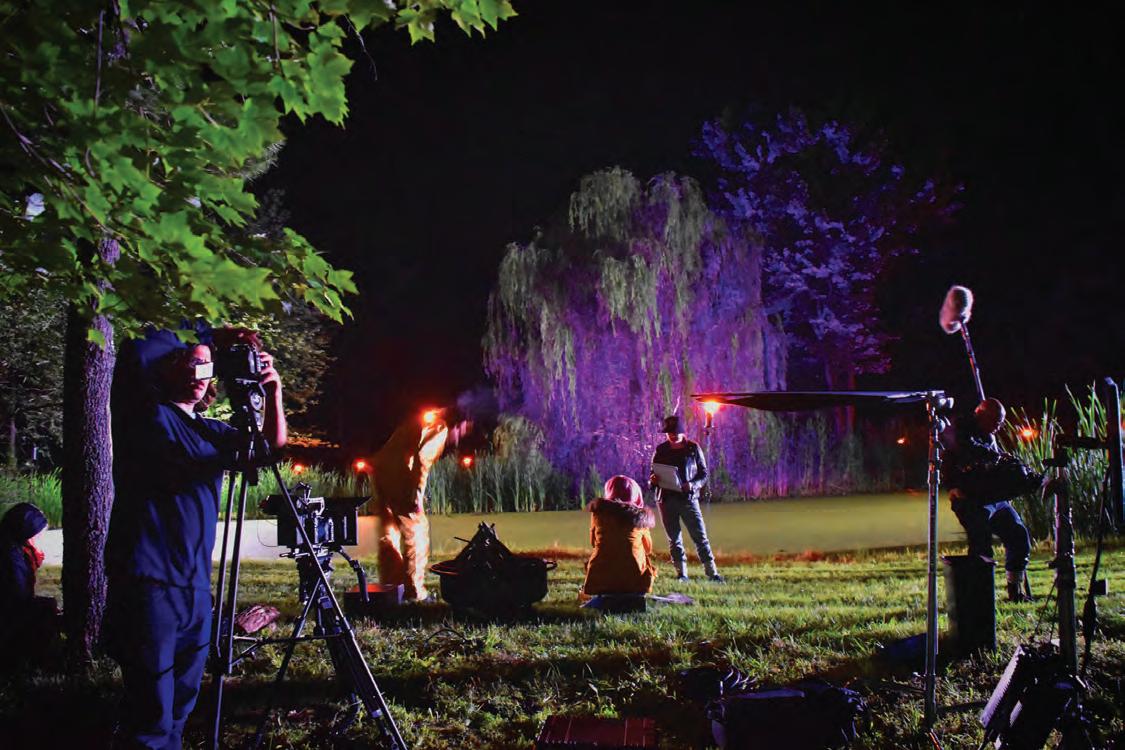
Imelda O’Reilly, Morgan Bullock and Gina Costigan on the set of Suspicious Minds Photo credit: David Giesbrecht
Imelda O’Reilly center directing Suspicious Minds at the Catwalk Art Residency Photo by: David Giesbrecht

It’s not always the case. As a director you are constantly making decisions, and hoping 80% of them will work. We also shot day for night, so when we filmed late in the day, we made sure to frame the sky out, so the footage would look more like night light. The two most challenging scenes involved lighting a big, green frog pond with only had three lights and one small generator for a night shoot. Thankfully, my very talented cinematographer, Joe Foley, worked his magic and lit this scene spectacularly.
We also filmed at White Eagle Hall in New Jersey. This was my most costliest shoot date. I had over 40 people on set, and we had to build a proscenium to the existing stage. We didn’t have a long time in the location, so we were under pressure to shoot everything we needed in one day. This scene had a dance sequence and a song, so the choreography was challenging. But in the end, it all worked out. We had a dolly shot that pulled it all together.
Your work describes a homeland and being away from home. Can you elaborate?
As an immigrant, and a nomad, there is a sense that you are caught in between two landscapes. It’s like being a cultural misfit. Shifting between cultures requires skill. It creates a sense of dualism in identity. Combined with inter-continental restlessness, it can be challenging.
So do you consider yourself Irish or American? That’s complicated. You return home and you are
perceived as an outsider, the “American.” Then you return to the States and don’t fully feel American. And of course, there are always references to your accent. I am both Irish and American, and feel a sense of home in both New York and Ireland. I just completed a trilogy of films around these themes: Eggs and Soldiers, Tumbling Towards Home and Suspicious Minds. Two have screened on RTE, Ireland’s leading television station.
Your themes explore identity and exile. How do they inform one another?
As I stated, I have a deep connection to the landscape in Ireland, where I spent my formative years. Ancestral trauma run’s deep. The more I travel, I discover it’s not the country that shapes one’s identity but one’s connection to its inhabitants. I spent my young adult years in New York City. Between both landscapes I have a homeland. I long underestimated my connection to both places. It is very rooted and layered and goes beyond the boundaries of culture. I have travelled and lived in many places - Paris, London, Singapore, Seville, Fez – but I always return to New York. My current home is Westbeth in Manhattan, and I am truly privileged to have found this artists’ community for artist housing and much more. We are all seeking our yellow brick road and our tribe. For me, making work is a pathway to find likeminded individuals who are also pursuing artistic ideas. Artists that come to mind are David Bowie, Bjork, David Lynch, Lynn Ramsey, and Willian Ken-
tridge. It was only when William Kentridge started blending all his art forms - prints, drawings, and animated films - that he realized his full potential. I am lately incorporating more experimental elements in my work and moving back toward the avant-garde art that inspired my earlier work.
Perhaps my artistic goal is to pursue all these creative endeavors in one giant work to fully comprehend a deep, meaningful practice. It requires dancing in the light over and over to uncover and deepen the emotional truth within a work. I started writing to hide my feelings, but as I mature I realize that revealing one’s feelings makes for more interesting work. This requires risk and trusting oneself - that’s where the personal power lies. Making art is my pathway. My poems are my hymn to life.
All life is beautiful, Aristotle said that art processes human elements of pity and fear to move the audience on an emotional level. I’ll continue to explore this dramatic and mysterious human process.
www.imeldaoreilly.com Imelda.oreilly@gmail.com
Imelda O’Reilly directing on the set of Suspicious Minds at the Catwalk Art Residency
Photo credit: David Giesbrecht

PATTIE LIPMAN
Lipman was born in Center City, Philadelphia and is now currently working in Rensselaer county, NY. Methods include a variety of traditional mediums, printmaking, sculpture and painting.
The artist has taught intaglio printmaking at the University at Albany. Currently working on small, figurative pieces in wax.
Pattie Lipman — plipman@fairpoint.net Pattielipman.com
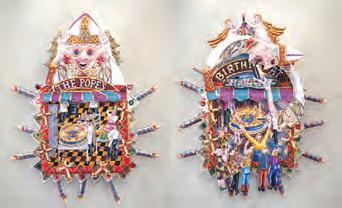
SUSAN FLEX GILBERT
I graduated from the School of The Museum of Fine Arts, Boston in 1981. For the next seven years I made and showed my work in different venues around Massachusetts some of which are Massachusetts College of Art, University of Massachusetts Amherst and the Brockton Art Museum. During that period I also had two daughters and decided to stop making art. For about twenty five years I raised my two daughters, indulged in another creative enterprise, baking,and trained myself to be a professional baker/cake decorator. I had my own baking business out of my house for three years and then went to work for one of my customers, Whole Foods.for five years. After that I worked for an upscale bakery and while working for each of these businesses I started making work and showing it again. I’ve been back in my studio for over fifteen years happily telling tales through my work.
Susan (Flex) Gilbert — 781-444-1335
sgflexart1@gmail.com | www.flexart.space


RICHARD BRITELL
Richard Britell is a painter, curator, teacher, and writer. The reach of his creativity and intuition can be hard to pigeonhole. Paintings of architectural details on small panels isolate areas of geometric interest found within greater structures. Within this cropped view, Britell establishes peaceful, albeit rhythmic, patterns of stacked bricks and wall relief embellishments that represent a kind of ordered permanence. The artist studied at Pratt Institute and has shown with Carrie Haddad Gallery for many years.
Richard Britell — rpb8080@gmail.com

Clams & fish Fry Acrylic on canvas 36” x 36”
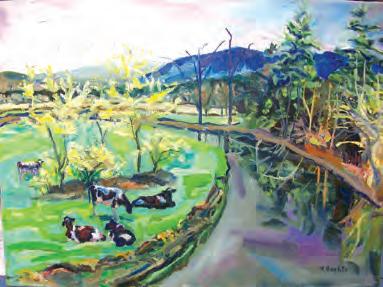
RIVERSIDE
(BARTHOLOMEW'S COBBLE, ASHLEY FALLS) OIL ON STRETCHED CANVAS, 18”X24”
MARGARET BUCHTE
Margaret works in oils, acrylics, watercolors and pastels with passion, joy and dedication,painting scenes of Berkshires and beyond and strives to capture the essence and beauty of each scene under dramatic light. Margaret has conducted mini-workshops of drawing/painting sessions.
Her artwork has been exhibited in juried shows, many solo shows, and in private collections. Margaret Buchte — fineartamerica.com/profiles/margaret-buchte https://facebook.com/MargaretsOriginals

BRUCE LAIRD
I am an abstract artist whose two and three-dimensional works in mixed media reveal a fascination with geometry, color and juxtapositions. For me it is all about the work which provides surprising results, both playful and thought provoking.
From BCC to UMASS and later to Vermont College to earn my MFA Degree. I have taken many workshops through Art New England, at Bennington College, Hamilton College and an experimental workshop on cyanotypes recently at MCLA. Two international workshops in France and Italy also. I am pleased to have a studio space with an exciting group of artists at the Clocktower Building in Pittsfield.
Bruce Laird — Clock Tower, #307, 75 South Church Street, Pittsfield, MA. Instagram: @ecurbart

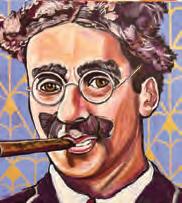

iLENE RICHARD
A vibrant force in the art world, Ilene Richard paints with acrylics and purpose —blending color, character, and comedy into unforgettable portraits. Her current passion?
Iconic comedic figures, captured with both wit and warmth. With a sharp eye, quick humor, and zero tolerance for nonsense, she brings fierce dedication and heart to everything she creates. Driven, funny, and fiercely herself — Ilene doesn't just make art.
She makes a statement.
ilene Richard — The Clock Tower Studio #336 75 Church Street, Pittsfield, MA 01201 ilenerichard5355@gmail.com ilenerichard.faso.com 978-621-4986


IN STUDIO
HARPO AND CHICO (TWO CANVASES, BOTH) ACRYLIC ON CANVAS, 20”X20”
Bubble Burst 24” x 30”

JANET COOPER THE ART OF FIGURING OUT WHAT KIND OF ARTIST I AM
Fabrics, anatomy, stitches, colors and bricologue are words, imbued with intense emotionality for me, a maker, collector and lover of objects and places.
My first love was clay, so basic, earthy and obsessively compelling, I adored making pottery shapes and objects, resembling torsos. A period of fascination with vintage tin cans, bottle caps and junky metal discards followed. Metal was sheared, punched, riveted and assembled into figurative shapes. I began to use fabrics with these works and eventually abandoned metal for hand stitching doll sculptures, totems and collages, all with second hand or recycled fabrics.
Lately I have introduced paint and waxes into my work. I also am using animal bones, those armatures of mammal form. I am recycling old works into the new, a kind of synthesis of who I have been with whom I am now.
I am also returning to jewelry or ornament making. as well as fashioning a collection of garden and street wear art aprons.
Janet Cooper— janetcoop@gmail.com www.janetcooperdesigns.com
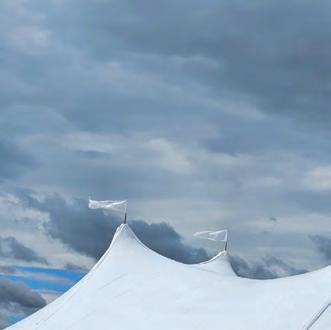

LESLEE CARSEWELL
My artwork, be it photography, painting, or collage, embraces a very simple notion: how best to break up space to achieve more serendipity and greater intuition on the page. Though simple in theory, this is not so easy to achieve. I work to make use of both positive and negative space to create interest, lyricism, elegance, and ambiguity. Each element informs the whole. This whole, with luck, is filled with an air of intrigue.
Breaking up space, to me, has a direct correlation to music. Rhythm, texture, points of emphasis, and silence all play their parts. Music that inspires me includes solo piano work by Debussy, Ravel, Mompou, and, of course, Schubert and Beethoven.
Working with limited and unadorned materials, I enhance the initial compositions with color, subtle but emphatic line work, and texture. For me, painting abstractly removes restraints. The simplicity of lines and the subsequent forming of shapes is quite liberating.
Lastly, I want my work to feel crafted, the artist's hand in every endeavor.
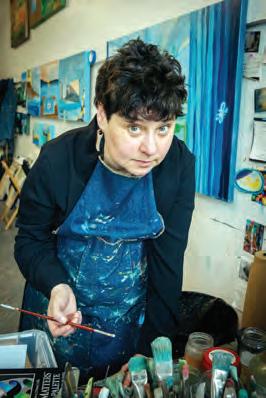
ALEXANDRA ROZENMAN
Alexandra Rozenman’s narrative about identity, search for belonging, and journeying to a foreign land forms the core of her work. She says, “my approach to beauty and wonder came with me from Russia and has kept playing a big role. I am always working with it or against it.” Her paintings tell stories and invite viewers into her world of images, symbols, historical events, and the lives and work of famous artists. Rozenman’s work touches in personal ways on issues of artistic influence and dialogue, emulation and creativity, and continuity and discontinuity in contemporary art. She shows us how we are all part of a larger story. In her most recent work, mainly done after the invasion of Ukraine, Rozenman uses trauma (e.g., floods, fires, emptiness) as subject matter, asking the viewer to think about the meaning of even the darkest things around us.
Voici des fruits, des fleurs, des feuilles et des branches Et puis voici mon cœur qui ne bat que pour vous. Ne le déchirez pas avec vos deux mains blanches Et qu’à vos yeux si beaux l’humble présent soit doux.
(Here are flowers, branches, fruit, and fronds, And here too is my heart that beats just for you. Do not tear it with your two white hands And may the humble gift please your lovely eyes.)
Leslee Carsewell— Prints available, please inquire. 413-229-0155 / 413-854-5757 lcarsewellart@icloud.com www.lcarsewellart.com

Rozenman was born in Moscow and emigrated to the U.S. in 1989. She was classically trained in the Soviet Art Academy and with well-known artists from Moscow’s underground movement. She lived in New York City in the 90s and was part of what later became Artists Alliance Inc. on the Lower East Side. Rozenman holds a BFA in Painting from SUNY and an MFA from the School of the Museum of Fine Arts at Tufts. She has studied with artists Gerry Bergstein and Robert Ferrandini. Her paintings and drawings blend the styles and symbols of folk art, illustration, Russian Underground Conceptualism, and Jewish Art. Rozenman exhibits nationally and internationally at venues that have included Lichtundfire Gallery in New York, Trustman Art Gallery at Simmons University, Hudson Gallery in Gloucester, MA, Flinn Gallery in Greenwich, CT, French Cultural Center of Boston, The Ann Loeb Bronfman Gallery in Washington, DC, Gallery 360 in Minneapolis, MN, The Painting Center in New York, and Moscow Center of Contemporary Art. Rozenman was a MacDowell Fellow in 2006. She leads her own art school for adults and teenagers in Somerville, MA called Art School 99. She is a member of Fountain Street Gallery since 2016.
Alexandra Rozenman — artschool99somerville.com www.alexandrarozenman.com alexandra.rozenman@gmail.com
WALL MURAL, MIXED MEDIA
Green
—Paul Verde 1800s
RICHARD TALBERT

My native American quest began in 1997 in Peru, on the Amazon River, the greatest river in South America and “ the most extensive drainage system in the world, regarding the volume of its flow and the area of its basin.” My journey began with the tropical rainforest sounds, walking through thick brown mud, and watching pink dolphins swim in the Amazon River. In the rainforest, I only had a large machete to cut through the wild grass, which made it easier for nature photographers to shoot tropical birds. Before that, I painted landscapes and photographed people in urban cities. Many of my paintings, drawings, and photographs are considered Abstract Surrealism.
Richard Talbert c, CUBA, 2016, Watercolor, 22” x 30”

ELLEN KAIDEN WATERCOLOR ARTIST
“I am drawn to watercolor as a medium because it is spontaneous and uncontrollable. The thought that you can capture motion and color in water adds to the medium’s excitement. My paintings are metaphors and are full of life and movement.”
Ellen creates watercolors that have an architectural but vitreous quality. Kathleen Bernhardt of Corporate Art Source, Chicago, and Kathleen Bernhardt Gallery, Sarasota, FL said that “Ellen Kaiden is to watercolor what Dale Chihuly is to glass blowing, that by taking a small object and giving it scale and attitude, create something uniquely her own.”
Ellen is a full-time painter, with studios in Boynton Beach, Florida and the Berkshires in Massachusetts. She was awarded with “Best Water Medium Artist 2023’’in the ADC, “Art Comes Alive” National Juried Show”. Presently her work is featured at Miraval, and Concepts of Art, Lenox,MA. Last summer, her work was presented as a nine-piece installation at Canyon Ranch, Lenox. She is a featured artist at the Solana Gallery of fine art, in Winter Park, FL, and Gallery 14, Vero Beach FL. She is represented by The WIT Gallery in Lenox, MA, Concepts of Art,Lenox and Gallery 14 in Vero Beach, FL. And Solana Gallery of Fine Arts, Winter Park.
Ellen Kaiden — Www.Ellenkaiden.com
La vie en rose
C’est quelque chose que J’ose d’imaginer tous les jours Franchement, je pense que J’aimerais voyager au lieu où Il n’y a pas des soucis, ou Du bruit
J’espère je peux laisser ma vie et tout le reste Pour y aller, pour ma santé
Je n’ai besoin un homme, je n’ai besoin de personnes
J’adorerais la solitude
Mais je n’aimerais pas une vie moyenne
Je veux inonder dans une piscine de fleurs
Où il est tranquille,et possible d’être content
D’être vraiment content.
—-Édith Piaf

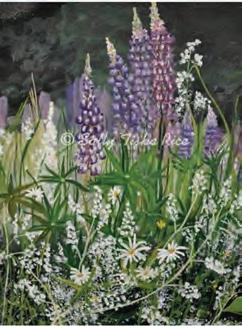
SALLY TISKA RICE BERKSHIRE ROLLING HILLS
Born and raised in the captivating Berkshires, Sally Tiska Rice possesses artistic prowess that breathes life into her canvases. As a versatile multimedia artist, Sally seamlessly employs a tapestry of techniques, working in acrylics, watercolors, oil paints, pastels, collages containing botanicals, and mixed media elements. Her creative spirit draws inspiration from the idyllic surroundings of her rural hometown, where she resides with her husband, Mark, and cherished pets.
Sally's artistic process is a dance of spontaneity and intention. With each brush stroke, she composes artwork that reflects her unique perspective. Beyond her creations, Sally also welcomes commissioned projects, turning heartfelt visions into tangible realities. Whether it's capturing the essence of individuals, beloved pets, cherished homes, or sacred churches, she pours her soul into each personalized masterpiece.
Sally Tiska Rice will be the featured artist at the Hotel on North, located at 297 North Street, Pittsfield, MA through September 1, 2025. Set in the heart of downtown Pittsfield, this beautifully restored boutique hotel blends 19th-century architecture with sleek, contemporary design—and is the perfect backdrop for Sally’s richly layered, lightfilled artwork.
Sally’s work is on the gallery walls of the Clock Tower, Open Monday-Friday 9:00-5:00 pm for self-guided tours.
SallyTiskaRice@gmail.com www.sallytiskarice.com https://www.facebook.com/artistsallytiskarice Fine Art Prints (Pixels), Twitter, LinkedIn Instagram, YouTube, TikTok


JAYE ALISON
"I was really anxious because we were pretty much snowbound in our homes, being in a particularly cold 2025 winter. I had moved many of my art supplies to my studio in Southfield, and had begun organizing works. The idea of playing with them, cutting some of the ones to which I felt drawn to do so, this had been playing around in my mind for a looooooong time, but this weather allowed me to take advantage of the opportunity- I couldn't go anywhere, so I could just focus and play."
Jaye Alison harnesses water-based mediums like acrylic and watercolor, influenced by a creative upbringing and artistic journey. Through abstraction and intuitive color selection, she captures the interplay between forms with lines that articulate deep-seated emotions. Her art resonates with joy and upliftment, transforming personal and worldly complexities into visual harmony.
The artist is passionate about creating art, painting on flat, smooth surfaces, and using environmentally friendly materials.
Alison’s work has been exhibited nationally and internationally and has appeared in print, film, television, the web, and Off Off Broadway.
Transforming personal and worldly complexities into visual harmony. In celebration of Jaye's new studio, enjoy 10% off large paintings and 30% off small paintings.
Jaye Alison — 310-970-4517
Studio visits by appointment only: Pond Shed (behind the Buggy Whip Factory), 208 Norfolk Road, Southfield, Massachusetts jayealison.com jaye.alison.art@gmail.com
FROM DARKNESS TO LIGHT COLLAGE, CRADLED WOODEN BOARD, 10”X10”X2”
BELIEF IN THE POSSIBILITIES OF SPRING COLLAGE, CRADLED WOODEN BOARD, 12”X12”X2”
TANGELWOOD, LENOX, MA, WATERCOLOR
WILD CHILD, 23”X29”


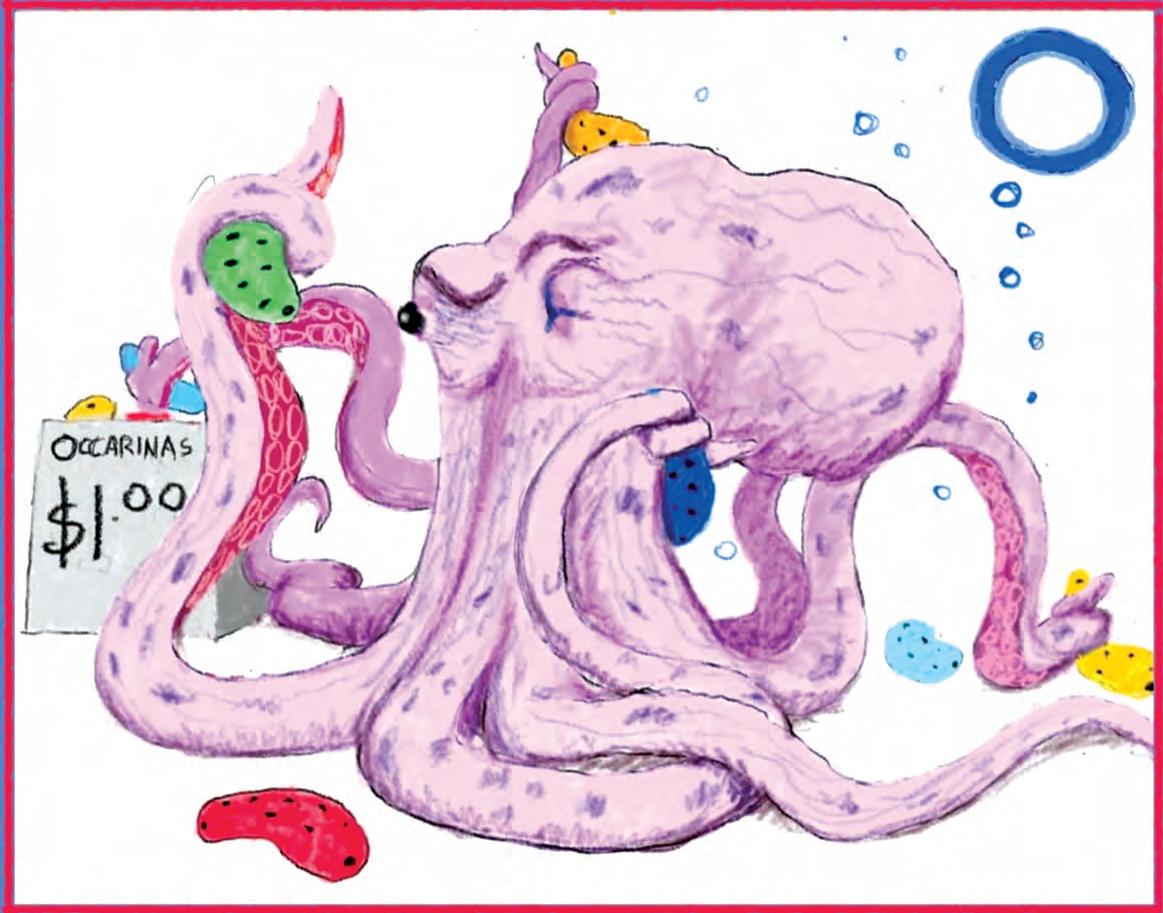



BRUCE PANOCK
I am a visual artist using photography as the platform to begin a journey of exploration. My journey began in earnest almost 14 years ago when I retired due to health issues and began devoting myself to the informal study of art, artists and particularly photography. Before retiring I had begun studying photography as a hobby. After my retirement, the effort took on a greater intensity.
My world had changed for reasons outside of my control and I looked for something different in my work. I wanted to do more than document what was around me. I wanted to create something that the viewers might join with me and experience. Due to my health issues, I found myself confined with my activities generally restricted. For the first time I began looking inward, to the world that I experienced, though not always through physical interaction. It is a world where I spend more time trying to understand what I previously took for granted and did not think about enough. The ideas ranged from pleasure and beauty to pain and loss; from isolation to abandonment; to walking past what is uncomfortable to see. During this period of isolation, I began thinking about what is isolation, how it can transition to abandonment and then into being forgotten. The simplest display of this idea is abandoned buildings. They were once beautiful, then allowed to run down and abandoned, soon to be forgotten. After a while they disappear. Either mankind knocks down these forgotten once beautiful structures, or remediates them, or Nature reclaims the space. Doesn’t mankind do the same with its own?
My work employs references to other photographers, painters, as well as sculptors. The brushwork of Chinese and Japanese artists is appealing for both its simplicity and beauty. Abstract art has its own ways of sharing ideas which are jarring and beautiful at the same time. Black and white and color works each add their own dynamic. My work is influenced by these art forms, often using many of them in a single composited image.
Bruce Panock— Panockphotography.com bruce@panockphotography.com Instagram @brucepanock

DEBORAH H. CARTER
Deborah H. Carter is a multi-media artist from Lenox, MA, who creates upcycled, sustainable wearable art. Her couture pieces are constructed from post-consumer waste such as food packaging, wine corks, cardboard, books, wire, plastic, and other discarded items and thrifted wares. She manipulates her materials' color, shape, and texture to compel us to question our assumptions of beauty and worth and ultimately reconsider our habits and attitudes about waste and consumerism.
Since she was eight, Deborah has been a sewing enthusiast, and she learned her craft by creating clothing with her mother and grandmothers. Her passion took hold as she began to design and sew apparel and accessories. After graduating with a degree in fashion design from Parsons School of Design in New York City, she worked as a women's sportswear designer on Seventh Avenue.
Deborah's art has been exhibited in galleries and art spaces around the US. She was one of 30 designers selected to showcase her work at the FS2020 Fashion Show annually at the University of Saint Andrews, Scotland. She has been featured in the Spring 2023 What Women Create magazine.
Deborah H. Carter has been featured in The Artful Mind, Berkshire magazine, and What Women Create magazine and was a finalist in the World of WearableArt competition in Wellington, New Zealand, 2023.
“Sending Messages” on display at Hancock Shaker Village, 34 Lebanon Mountain Rd, Hancock, MA. Through November 30th. Deborah H Carter — 413-441-3220, Clock Tower Artists 75 S. Church St., Studio 315, 3rd floor Pittsfield, Massachusetts Instagram: @deborah_h_carter Debhcarter@yahoo.com
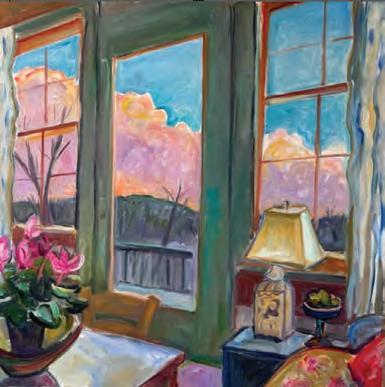
FRONT ST. GALLERY
Pastels, oils, acrylics and watercolors, abstract and representational, landscapes, still lifes and portraits, a unique variety of painting technique and styles you will be transported to another world and see things in a way you never have before join us and experience something different.
Painting classes continue on Monday and Wednesday mornings 10-1:30pm at the studio and Thursday mornings out in the field. These classes are open to all...come to one or come again if it works for you. All levels and materials welcome. Private critiques available. Classes at Front Street are for those wishing to learn, those who just want to be involved in the pure enjoyment of art, and/or those who have some experience under their belt. Kate Knapp — 413-528-9546 at home or 413-429-7141 (cell) Front Street, Housatonic, MA. Gallery open by appointment or chance anytime. www.kateknappartist.com

“IN

UPROOTED PHOTO: KORENMAN COM MODEL: LAURA LIN HEALING ARTS
BLUE TREE
KATE KNAPP, VIEW OF THE CLOUDS FROM THE COUCH OIL ON CANVAS SOLD
On the streets of Paris in the 1950s. The Red Balloon. A film by ALBERT LAMORISSE
GOOD

SUMMER WORK, DETAIL, 2025
JENNIFER PAZIENZA
Summer Work is a 72in / 183cm square oil painting on canvas. It is my response to an unassuming area in the vast landscape surrounding my studio on Keswick Ridge in New Brunswick, Canada. Although Canadian / US political relations may be strained, Summer Work defies such constraints. While favouring the poetic over the overtly political, it reveals my faith in the healing power of landscape imagery. To counter today’s personal and communal uncertainties and ultimately find connection and reconciliation, in Summer Work I hope viewers take the time to absorb its contemplative and restorative power.
An award-winning painter Jennifer Pazienza has 40+ solo and group shows to her credit in Canada, the US and Italy. Her paintings reside in permanent and private collections in Canada and abroad including, provincial gallery the Beaverbrook Art Gallery, Fredericton, NB, McCain Corporation, Florenceville, NB, White Plains Hospital, White Plains, NY, Misterbianco, Sicily, and Treviso, IT. She is represented by Gallery 78, Fredericton, NB and Alex Ferrone Gallery, Long Island, NY. Jennifer Pazienza — Visit my websitewww.jenniferpazienza or IG@jenniferpazienza

JOANE CORNELL FINE JEWELRY
“What a truly amazing experience it has been to be honored with the cover of the June issue, as well as the amazing interview, via the questions from Harryet!
The outpouring of acknowledgment/congrats was an incredible experience.So much so, that it renewed my understanding for the want of hand forged artisanal designed jewelry.
The comments from so many customers, as well as people I’ve never met before, about enjoying the “art” aspect of my designs, is what has renewed in me a surge of propose, beyond my normal desire to create.
I do believe, as all/most (and I hope you don’t mind me speaking for you), artists acknowledge to themselves, that we “need“ feedback.
It’s our life blood to know that we are wanted/needed and appreciated! As well as the purchases, of course!
So forging forward, (chuckle), I can’t wait to show you what I am cooking up in my studio, which I will be producing throughout the balance of the months left in 2025.
Thank you all for supporting me throughout these many years. 23 and counting!”
Joane Cornell Fine Jewelry — 917-971-4662 9 Main St., Chatham, NY joanecornellfinejewelry@gmail.com Instagram https://issuu.com/theartfulmindartzine/docs/the_art ful_mind_june_2025

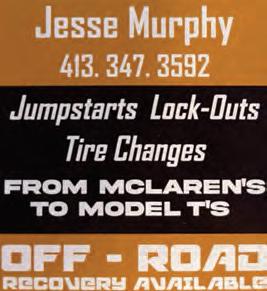
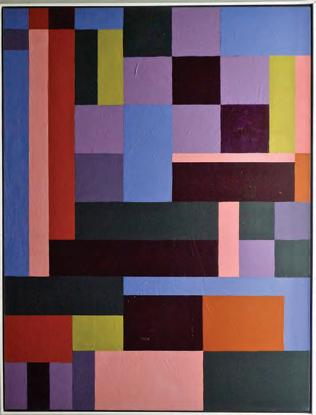
JJ (JAY) TOBIN
“I primarily use house paint because it is acrylic and mixed with artist's paint. The canvas from the life net is thick and coarse. You can't stretch it so that I will use it as collage material.” —JJ Tobin
What were some of your most memorable experiences working as a full-time artist?
JJ: Twenty years ago, I took a course in painting using fresco, which is pigment in wet plaster. The Sistine Chapel is probably the most famous. It was given at the Frelinghuysen-Morris house in Lenox. I painted a large mural using fresco at East Coast Refinishing on Industrial Drive in Pittsfield. It was great making the plaster and painting such a large piece. (10ft x 20ft). Looking at it now, I would change a lot.
When creating your black-and-white paintings, what challenges did you set for yourself to test your skill and ability to produce aesthetically pleasing work?
JJ: I have been doing black and white paintings on and off since the late 1970's. At Umass, I had John Grillo for a painting class. I did a black and white painting that he thought was awful. He told me about an artist he knew who used black and white almost exclusively. His name is Myron Stout. Stout has had a big influence on my work. I try to set up these paintings so the black shape or negative space and the white positive space are "nice looking shapes," as Grillo called them. I try to get the black and white shapes to play off each other. One isn't more important than the other. Certain objects lend themselves to just two colors. A firefighter's facepiece or a drop of liquid, for example.
To read full interview, please plug in this link: https://issuu.com/theartfulmindartzine/docs/the_a rtful_mind_.._nov_2024_online
JJ will be in The Artful Mind Group Exhibit, In Good Company, at 11 Eagle Street this summer starting Augsut 1. Please visit the gallery.
PEARLS, SPINEL BLACK DIAMONDS, EMERALDS
METROPOLIS, ACRYLIC ON CANVAS, 40”X30"

THE FARM IN SPRINGTIME MIXED MEDIA ON PAPER, 10”X8”
SCOTT TAYLOR
“I love to paint! I love everything about it, from the first brush load of color to the last — and especially how the paint feels as the brush moves it around the canvas. Often when I start a painting, I have an idea and direction for what I expect the piece to be, but at times the painting will take on a life of its own. I paint today becuase I have to; it has become what I do.
Ultimately, I hope the end result will give someone else the same pleasure in looking at the piece as the joy that I get out of creating it.”
Scott Taylor —scotttaylorpaintings@nycap.rr.com

BOBBY MILLER
Bobby Miller is a poet and photographer who lived and worked in New York City for thirty years. He has also the author of 23 books including — Fabulous! A Photographic Diary of Studio 54, A Downtown State of Mind: NYC 1973 – 1983, Wigstock in Black & White:1985 – 2005 and Queer Nation
Bobby has published three books of poems, Benestrific Blonde, Mouth Of Jane and Rigmarole and is included in several anthologies: Aloud: Voices from the Nuyorican Poets Café, Verses That Hurt, Pleasure and Pain from The Poemfone Poets and The Outlaw Bible Of American Poets. His work has been shown in New York City, Provincetown, MA, Palm Springs, CA, Seattle, WA, Hudson, NY and the Berkshires, MA. Bobby Miller — troubleblonde@comcast.net
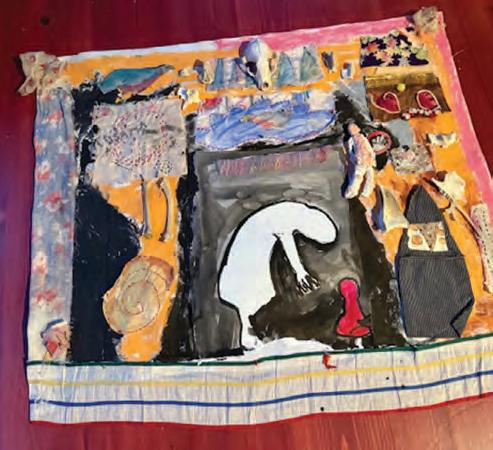

SARAH HORNE
I find myself drawing and painting primarily from nature. I am an abstract painter and I don't look to copy nature so much as I want to evoke the feeling I have about the subject. I want to capture a moment that has affected me.
The images I paint first come under my own looking and investigating, usually done with drawings and photographs. That done to my satisfaction, I let all of that initial process go. Then, I can paint with freedom and without over-thinking.
Sarah Horne — sarahhorne29@gmail.com
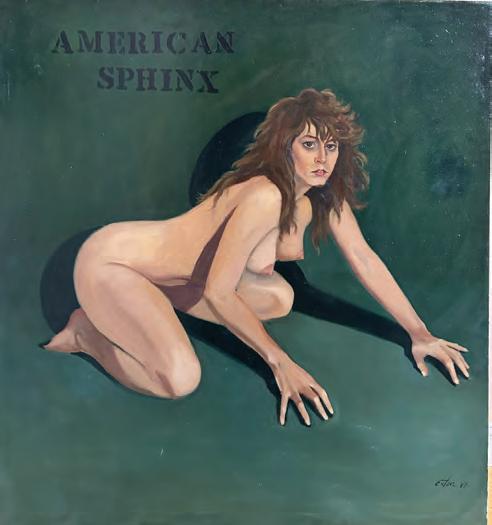

DAY CLOUD, JOHNSON, VT. ACRYLIC AND PASTEL ON PAPER, 11”X14”
ANDY WARHOL, 35MM FILM & DIGITAL IMAGE, ARCHIVAL INK AND PAPER
Erika Larskaya
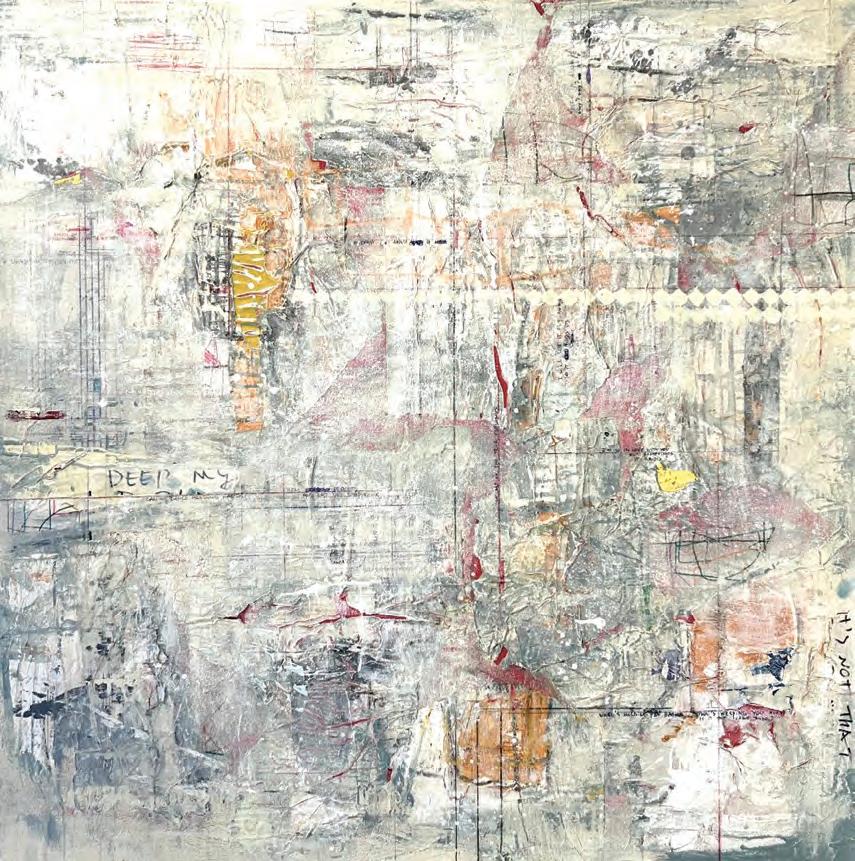
“Impermanence” Mixed media on canvas 36” x 36”
"As an abstract artist, I search for ways to represent the invisible, subtle, and unexpressed. I am driven to lay out fleeting and intangible experiences on physical surfaces.”
Erika Larskaya Studio at 79 Main St. Torrington, CT www.erikalarskaya.art

CANDACE EATON
Each gesture is its own psychological statement - I am constantly synthesizing my emotions and thoughts with the images given to me from the collective unconscious. The unfolding of the life force within me as it comes in contact with the given world about me, motivates me creatively.
The heart of the human experience, when it comes in contact with the numinous, is beyond the “fashion” and style of art and does not belong solely to any movement.
As an artist who watches the increasing labelhungry consumer oriented society we are immersed in, I eschew the need to have my personal, creative work become only a product ,easily identified into a movement, like generation decade tagging- another very easy, glib mode of identifying and explaining something the way a product often is advertised and sold. This very self-conscious awareness of the trends in current art history, reduced to decades, impedes true authentic work for many artists. This is why I choose to paint my Archetype Series in a generalized, somewhat traditional representational manner-- It is believable enough to allow me the subtle manipulations I sometimes need to bring out a psychological statement-an enlarged hand or exaggerated posture, become believable when it is outside the time we are standing in…If an image appears to be created in a nonspecific time it is established as present, here because it already has been… My Horses are from the winds of spontaneity. For as much thought and reduction that go into the figurative paintings, many of the Horse Series simply are a result of playing with the painting as I let it create itself on the canvas. I doubt I would be painting these had I not spent several years painting abstractly, being aesthetically aware of strong composition. I have very little to verbalize about these Jazz Horse paintings. They are spontaneous images that evolve as I let the muse dance.
Candace Eaton — www.candaceeaton.com candaceeatonstudio@gmail.com
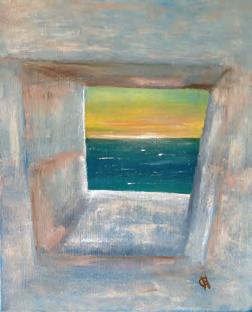
GHETTA HIRSCH
Here is the view from my place this July. I still cannot walk in the sand as my cane is of no use for that. I am healing but my leg is not ready for walking. Yet, it is nine months since my horrendous fall and breaks. So, I find ways to sneak closer to this ocean. I sit on hard stone walls to just see the waves through the openings I can find. I think of places where water has been destructive this Summer, of angry rivers, of lost children, of nature ravaged and more. Then, I thank this secure Atlantic Ocean for the peace it gives me as I rest and meditate. I hope you find your peaceful corner this month.
Meanwhile, I am still painting and my Williamstown Art Studio will be open for visits starting in August. Make an appointment to see my new work at 413-597-1716.
Also visit the gallery in North Adams where I will have paintings through August.
“IN GOOD COMPANY” exhibit at 11 Eagle St. Come to the Opening Reception on August 9, 58pm. If you cannot make it to the Reception the hours will be 11 to 4:30 Wednesday to Sunday, call ahead if you are coming from a distance to visit the gallery.
Ghetta Hirsch — Ghetta-hirsch.squarespace.com

JESSE TOBIN McCAULEY
Jesse Tobin McCauley's current work is all about freedom, wild abandon and just not thinking or worrying about anything - just having fun and finding happiness is bright vibrant colors. Let loose, draw funny lines, make mistakes and embrace it all! Jesse is an artist and graphic designer. She creates out of her studio at the Lichtenstein Center for the Arts. She studied graphic design and photography at Otis College of Art and Design in Los Angeles. Jesse’s work has been collected across the US and her large-scale murals can be seen throughout the Berkshires.
Jesse Tobin McCauley jessetobinmccauley.com @mooreofthetobin

What does a red �� mean? So, sending a red balloon emoji is a definitive signal of your happiness with life, and that's like a totally scientifically proven fact. In a similar vein, a red balloon emoji can be used to show that you have no worries.
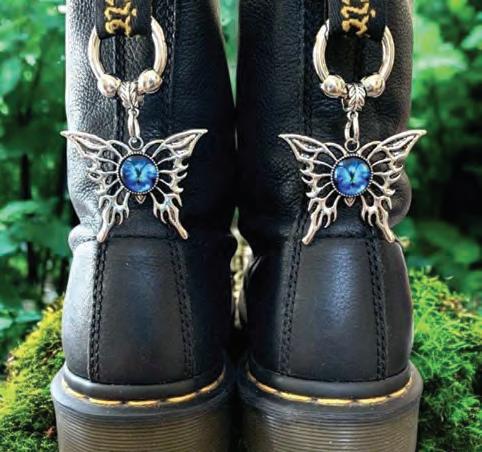
Where ordinary charms become wearable magic — keychains, bracelets, earrings, boot charms and more. Find a charm that speaks to you!

Boot Jewelry
OUVERTURE, OIL ON CANVAS, 10“X12”
WHIRLING GREENS, ACRYLIC ON CANVAS, 24"X30"
AMERICAN EVE, OIL, 36”X48”
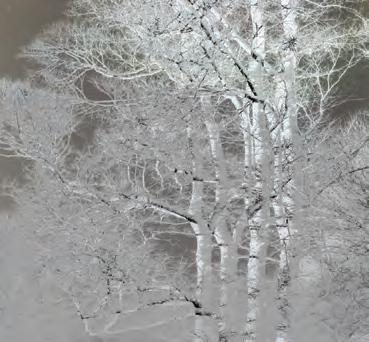
JANET PUMPHREY PHOTOGRAPHY
Janet Pumphrey’s traditional, representational photographs span the genres of portraits and street photography, vintage and sports cars, travel, landscapes, and wildlife. While photography is a representational medium, Pumphrey also moves beyond the inherent realism in traditional photography to see the world in a new and more creative way. Her work is painterly, sometimes abstract, sometimes impressionistic. Each piece is a unique, creative interpretation of a realistic image. Currently, Pumphrey shows her work at the 510 Warren Street Gallery in Hudson, New York. From June, 2020 until October, 2024, Pumphrey showed her work at the Janet Pumphrey Gallery in Lenox, Massachusetts. Previously, she showed her photographs in many galleries in the Berkshires and in the Hudson Valley.
Janet Pumphrey —
An interview with Janet Pumphrey is in the July 2020 Artful Mind:
https://issuu.com/theartfulmindartzine/docs/the_artful_mind_july_2020_issue_enjoy
and an interview and tour of her gallery is here: https://www.youtube.com/watch?v=wYHhXtSWl-g Facebook - Janet Pumphrey

CAROLYN M. ABRAMS INSPIRATIONAL AND ATMOSPHERIC SOULSCAPES
My work is about relationships. Connecting with my creative spirit and the world around me, most especially Mother Nature in all her beauty and her challenges. There is a voice in nature that touches us and connects us to one another in ways that evokes an emotion and stirs the soul. My work is about creating that connection. It is a metaphor for so many ethereal moments in life that are fleeting and bring with them a bond like no other. Using unique mediums such as oils and cold wax, I feel that relationship as I work layering, adding, subtracting, constructing and deconstructing on canvas, paper and wood panels. Mark making is a must to infuse my energy in each work and you will find each of my atmospheric "soulscapes " intuitively honors this affinity with Mother Nature. My work can be found online at www.carolynabrams.com and in the gift shops at Chesterwood and Becket Arts Center as well as upcoming venues throughout the Berkshires
If you are interested in learning more about the medium, I will be facilitating a one afternoon intro workshop at the Berkshire South Community Center in September. For more info contact me or look for sign up info late August/early September at the Guild of Berkshire Artists website www.berkshireartists.org or though the community center.
Carolyn M. Abrams — www.carolynabrams.com Member, Guild of Berkshire Artists
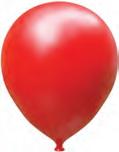
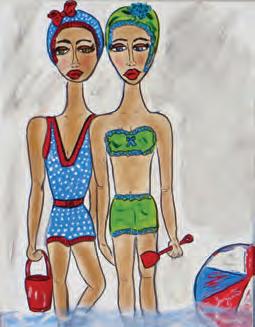

“SWIMMIES”
MARY ANN YARMOSKY
My work is a collection of a variety of people, a collection of experiences and expressions. It’s about understanding their history, understanding the power of their history, the power of their power, the power of their vulnerability, the power of transformation, and the power of purpose.
My works are abstract in nature, but aren’t we all pieces put together by our life experiences? Who is to say what is real when we look at a person. Don’t we always project onto them some characteristic we think we see, some fleeting feeling that crosses their face, or some mannerism that indicates their comfort or discomfort?
I work mainly with acrylic on canvas, paper or wood and often add fabric, thread or other artifacts that seem to belong. My process unfolds unintentionally since my characters dictate what needs to be said. I invite you to weave your own story into my works. You can decide what is held in an expression, a certain posture or the clothes they wear. I hope you enjoy the adventure as much as I do. Mary Ann Yarmosky — instagram: @maryannyarmoskyart
Eagle Street in North Adams, MA has historically been home to a diverse range of businesses, including cobblers, hat makers, tailors, and army-navy stores, which have evolved into toy stores, restaurants, and artisan shops ...
North Adams, MA was first settled in 1745 during King George's War, when the most western of a line of defensive forts was built along the bank of the Hoosic River, and occupied by Massachusetts militiamen and their families.
FROZEN, PHOTOGRAPH
“DEVOTION IN BLOOM”
HOLY ENCOUNTER OILS/COLD WAX

TENDING THE
YANA VAN DYKE
Yana van Dyke is a Conservator at The Metropolitan Museum of Art since 1999, specializing in the conservation of works of art on paper and parchment. Connoisseurship, scientific study, art historical research, and practical matters intertwined in caring for and preserving works of art fuel van Dyke’s investigations into artists materials and techniques. Curiosity, experimentation, and a passionate pursuit of knowledge guide her own creative process.
Yana Van Dyke — vandykeyana@gmail.com
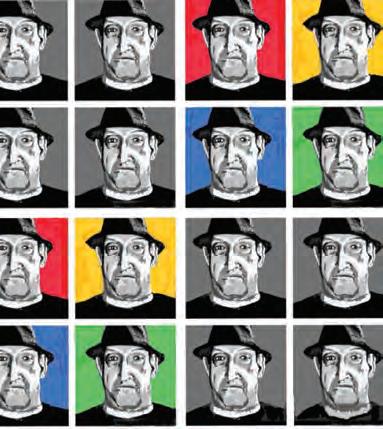
RICHARD NELSON
Art is therapy for me. A good way of processing my own personal baggage. I illustrate, in detail, whatever particular ism that I am dealing with. It helps me to see it and give it a face, so to speak. But the nature of it is too personal to share openly, so I obscure it until it is no longer discernible. I know it's there, but only I know. It's very cathartic! nojrevned@hotmail.com
Richard Nelson — Rick Nelson on FB nojrevned@hotmail.com
Rick Nelson on FB
Visit HOTEL ON NORTH - Pittsfield, MA Artist til’ Sept 1.
Sally Tiska Rice


Studio 302, 3rd floor 75 South Church St, Pittsfield, MA (413)-446-8469 www.sallytiskarice.com sallytiskarice@gmail.com

STEPHAN MARC KLEIN
I have been sketching and making art on and off since my undergraduate education as an architect in the late 1950s. What interests me at present about creating art, besides the shear visceral pleasure of making things, of putting pencil or pen or brush or all of them to paper, of manipulating images on the computer, and of making models, is the aesthetic tension generated in the borderlands between the abstract and the representational, between uniqueness and reproduction, and between analog and digital processes. I am also interested in art that engages the social, the political and the visual. Since my wife, artist Anna Oliver, and I made our home in the Berkshires six years ago, I have been entranced by its beauty. My work is, in part, a visual rhapsody to the area.
Stephan Marc Klein — stephanmarcklein.com | smk8378@gmail.com Member 510 Warren Street Gallery, Hudson, NY


“No one is born hating another person because of the color of his skin, or his background, or his religion.” - Nelson Mandela
Nelson Rolihlahla Mandela was a South African anti-apartheid activist and politician who served as the first president of South Africa from 1994 to 1999. He was the country's first black head of state and the first elected in a fully representative democratic election.
artist, illustrator, writer, poet, peace lover elizabeth cassidy studio works elizabethcassidystudioworks.com
ON WEST ROAD ENTERING THE VILLAGE, ALFORD, MA INK DRAWING
Aunt Evelyn’s Poppies 60”x48” Acrylic on Gallery Canvas

JANE GENNARO
Jane Gennaro is an artist, writer, and performer based in New York City. Jane’s work has been widely exhibited, performed, and broadcast. She has been featured in the New York Times, New York Magazine, and NPR among others. Her illustrated column, "Mining My Life” appears monthly in The Artful Mind magazine. Jane’s art studio is in Claverack, NY.
Jane Gennaro — www.janegennaro.com shop.janegennaro.com https://performingartslegacy.org/

HOUSATONIC : OUR RIVER ACRYLIC ON CANVAS 24”X24”
RUBY AVER STREET ZEN
Growing up on the Southside of Chicago in the 60s was a history rich and troubled time. As a youth, playing in the streets demanded grit.
Teaching Tai chi for the last 30 years requires a Zen state of mind. My paintings come from this quiet place that exhibit the rich grit of my youth . Movement, shape and color dominate, spontaneously combining raw as well as delicate impulses. My recent series, Strike a Pose, is inspired by the dance genre Voguing. Colorful feminine images with amplified characters grace the canvas with their mystery.
Ruby Aver— Housatonic Studio open by appointment: 413-854-7007 / rdaver2@gmail.com Instagram: rdaver2

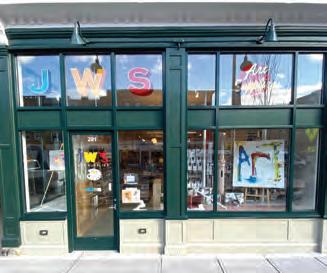
JWS ART SUPPLIES
WE’VE MOVED!
Welcome to JWS Art Supplies at our new location, 291 Main Street in Great Barrington. We're excited to offer a wide variety of art supplies and craft materials for artists of all ages and skill levels. Whether you're a parent looking for fun projects for kids or a professional artist seeking high-quality materials, we have something for everyone.
Our knowledgeable staff is here to assist you with whatever project you're working on. Don't hesitate to ask for recommendations or guidance—we're dedicated to helping you find exactly what you need to bring your creative vision to life. Visit us and explore our extensive selection of art supplies!
JWS Art Supplies — 413-644-9838 - 291 Main St, Great Barrington, MA. info@jwsartsupplies.com


Valeria and the Ants CHAPTER 3
The Square Root of Two
The Elephant was Valeria’s best friend. She had a great many acquaintances certainly, living in the middle of a carnival troupe, but she was only truly close to the Elephant. When she found that she was, “Not on speaking terms,” with him, she did what anyone might do, she sought out the friendship of someone else to confide in.
As you probably know yourself, this never works out in any satisfactory manner. The backup friend never seems to really understand the situation, and often simply feels used and imposed upon. In Valeria’s situation she decided to talk to, and confide in the Ant Syracuse
How would I know the details of Valeria’s conversations with the Ant Syracuse? Simply because at the time of the events related here, I was also one of Valeria’s acquaintances, and so it happened, to my great good fortune, that she confided in me also at the time.
I happened to be working at the carnival, just for the summer at first. I had been planning to go to college, but unfortunately I was rejected by all three of the colleges I applied to. Actually, I was rejected by two of them, and I was on a waiting list at the third school. Being put on a waiting list was somehow even more irritating than an outright rejection. I had applied to only the very best schools, Harvard, Princeton, and Yale were my choices. Harvard and Yale rejected me, but I was on the waiting list for Princeton.
In September, after the semester began I received a very nice letter from them. I had finally received a rejection from Princeton as well, but several freshmen died in a car accident, and so there were several unexpected openings that September, but I sent them a rejection letter! I rejected their damned college, and nothing would have induced me to go there, not even with a scholarship, which they did not offer to me.
When my high school counselor heard that I had been put on the waiting list to go to Princeton he called me down to his office. His name was Mr. Bridges, and I hated him. He had terrible habits. If you went into his office he would invariably be reading something, and without looking at you he would gesture for you to take a seat, with a dismissive wave of his hand. Then what seemed like hours would go by, and finally he would look up over his glasses and say something insulting to you.
“Whatever possessed you to apply to Yale and Harvard. You like to waste people’s time? There was no possibility, with your grades, and your history, that those schools would ever read all the way through your application. You have always been in the bottom third of your class.”
“I’m on the waiting list at Princeton” I said to him in anger, spit unexpectedly flying out of my mouth as I said it.
“That is why I called you down here, to talk to you about it. That has to obviously be some mistake, and I think you should not get your hopes up about it, it is probably some sort of a mistake, some filling error. There is most likely a person with a similar name and the letter was probably sent to you in error. I have a call in to them right now, because I want to clear up the matter as soon as possible. I just don’t want you going around telling people about this, I am trying to help you, and spare you a terrible embarrassment.”
Then his phone rang. It was one of those happy situations where fate inserts itself into your affairs, and contradicts the outline someone has already written for you. It was an administrator at Princeton, calling Mr Bridges to tell him that I was, indeed, on their waiting list. Mr. Bridges said absolutely nothing during the phone call but it was obvious from the consternation, on his face, that he was talking to the school about myself.
But just consider this, Mr. Bridges was my counselor, his job was to encourage me, to be happy with my accomplishments, but No, my success was somehow a slap in the face to him. Why, he should have been beaming with pleasure, he should have jumped up from his chair, come round the desk and given me a pat on the back. In actual fact, he was unable to conceal his disappointment in my accomplishment.
To tell the truth, however, I myself also thought it was a mistake, some obvious mistake. I had received the notification in the mail the day before, and I went right to the phone and called them up. I discovered that I was indeed on a waiting list, and they were specific about it. I was 49th on a list of 51 names.
Then transpired in my life a strange moment of epiphany. Some respected strangers somewhere thought that I was worth something. It was a perfect moment, and yet, I couldn’t really believe it. Like my counselor, I felt that it had to be some sort of a mistake.
There was only one strange and remote possibility of an explanation, it might have been because of a recommendation written by my algebra teacher, Mr. Jory, with whom I had a peculiar relationship. It began one day when he was explaining irrational numbers to us, like pi and the square root of two. I sat there in class and listened to what for me constituted a monstrous travesty. How could there be “irrational,” numbers? If there was one thing in this world that was completely rational it would have to be the world of numbers. I was so aggravated by the idea that I raised my hand and when Mr. Jory asked me what I wanted I had nothing to say, I was unable to formulate any argument about the problem that the square root of two presented.
After class I approached him timidly and tried to voice my objection to the idea of irrational numbers. He was very pleased by my questions saying, “Young man, you come from a long line of thoughtful people who object to the square root of two. Many famous mathematicians began their careers because of their objection to the concept. “Now,” he said, “let me show you the proof that the square of two must go on forever.” With that he took up the chalk from the chalk tray, and began writing a series of numbers and symbols on the chalkboard, stopping now and then to look at me with a significant expression of pleasure on his face, like as if he was
playing the violin.
Finally he finished his “proof,” and turned to me with satisfaction saying, “Now do you see!”
Yes, I see.” I said, but I was lying, I had no idea at all what his proof meant but I was just too embarrassed to let him see how stupid I was.
But there was a more important connection I had with that man having to do with a profound personal struggle he lived with. Mr. Jory was “shell shocked.” I do not know what the proper term is for the condition, but everybody said he was afflicted in that way. He was always jumpy and nervous and one time the wind blew the door shut, and for a moment we thought he was going to pass out. Another time one of those huge window shades rolled up suddenly with that machine gun sort of rattling sound, and the poor man turned perfectly white. It was said that students in his classes would sometimes, when his back was turned to the class, that it sometimes happened that a student would lift the lid of a desk and then slam it down in order to persecute the poor man. I did not believe that anyone had actually done this, but then, one day a student sitting next to me did it twice. Mr. Jory’s reaction was not anything extreme, but he stopped what he was doing and bowed his head a little, and his piece of chalk made a cracking sound, but then continued with what he was doing. A few seconds after he had recovered himself the desk banged again, and then he started to turn around, thought better of it, and finished his work on the chalkboard. As I remember, it was the Pythagorean Theorem.
When the bell rang there was the usual scraping of chairs and the gathering of books and we all stood up to go. The desk banger next to me had a very large quantity of books and papers that day, and he was hugging them all in both arms when Mr. Jory walked up to him and took hold of him by the shoulders. Then Mr. Jory began to shake the desk banger violently back and forth, left and right and then back and forth again, for good measure. All his books and papers flew about the room, and still the shaking continued. On Mr. Jory’s face was a look of such pure rage that I suppose it was the kind of look one might see on some person's face, just immediately before a homicide.
Finally Jory stopped what he was doing, perhaps aware of how extremely out of the acceptable order of things he had gotten, and looking around his eyes met mine, and he could clearly see how overjoyed I was to witness what he was doing. Yes, I was happy with Jory that day, he could have been fired, but he was doing the just, right, and only thing that had to be done. Perhaps it was just my imagination, but from then on he began to refer to me by my name instead of “Young Man.”
So, I went to Mr. Jory, and I asked him what he wrote about me in his letter of reference, and he said, “I said you were one of the best of the students I had to fail, and that you hated the square root of two. And to not forget that Einstein failed his way out of high school also.
But in the end, I didn’t go to Princeton, or any other college. But do you imagine, even for a single second, that going to a college could ever be compared to working, even for just a summer, at a Carnival?
—RICHARD BRITELL
JULY, 2025
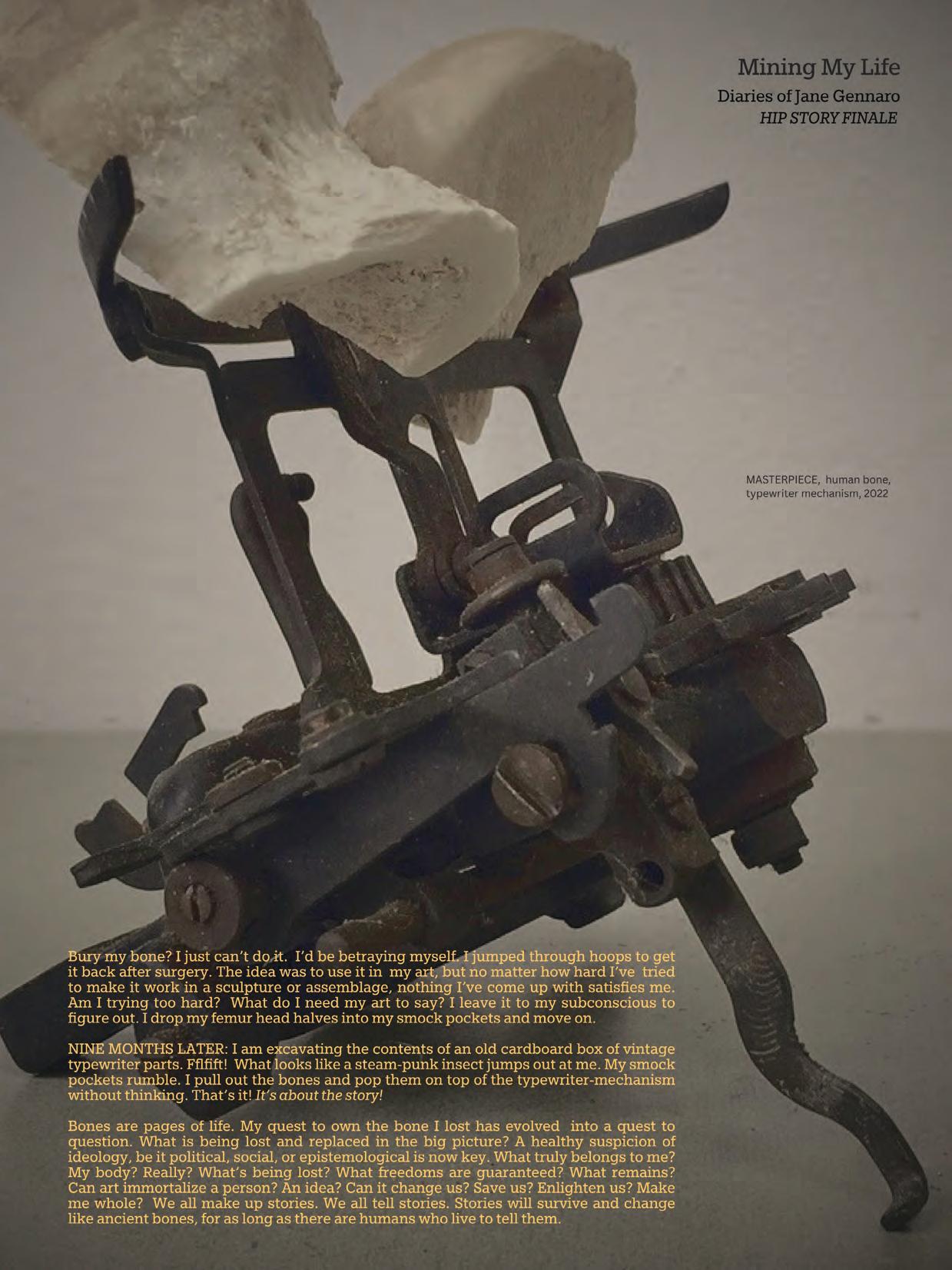


Deborah H Carter Still Tea with Life
Photo: Korenman.com
Model: Francesca Stanmeyer
Represented by the WIT Gallery Clock Tower Artists
